A Review of Strategies for the Synthesis of N-Doped Graphene-Like Materials
Abstract
1. Introduction
2. Plasma-Assisted Synthesis of N-Doped Graphene
2.1. One-Step Plasma Deposition Procedures
2.2. Plasma Post-Treatment Procedures
3. Non-Plasma Synthesis of N-Doped Graphene
4. Summary of the Literature Review
5. Discussion
- (1)
- No general correlation between the nitrogen content and the characteristics of N-doped graphene samples was found. Sometimes, even very low nitrogen content of about 1 at.% was found beneficial. The induced defects increase with increasing nitrogen concentration, but this observation should be taken with a precaution because the effect of oxygen was not always included.
- (2)
- Nitrogen is usually present in various configurations such as pyridinic, pyrrolic, and graphitic. Sometimes also oxidized nitrogen groups were reported. Usually, all three typical nitrogen configurations are found, but they differ in concentration among authors. There are only a few papers where mostly only one nitrogen configuration was reported i.e., pyridinic [34] or graphitic [36]. Therefore, it is still a challenge to control the type of nitrogen incorporated into the graphene-like structures.
- (3)
- Treatment times for N-doping were mostly of the order of 10 min (without taking into account the time needed for the preparation of the pristine graphene samples in the case of the two-step procedure). In rare cases, treatment times of the order of 10 s were reported [29,41]. RF plasma was used in both cases.
- (4)
- Systematic investigation of N-doping versus treatment parameters were provided in several papers. For example, the discharge power was varied systematically in [19,26], pressure in [27], and treatment time [1,11,24]. It should be stressed that such systematic experiments take time, especially spectra acquisition and the interpretation. Comparison of surface finishes obtained by different gases (N2 and NH3) using the same experimental system was reported in [29].
- (5)
- Nitrogen content in graphene-like materials is generally higher when using N2-plasma than NH3-plasma. Furthermore, in addition to pyridinic, pyrrolic, and graphitic nitrogen, the presence of amino groups was reported for NH3-plasma treatments.
6. Conclusions and Perspectives
Author Contributions
Funding
Conflicts of Interest
Abbreviations
| CNWs | Carbon nanowalls |
| ECR | Electron cyclotron resonance |
| MW | Microwave |
| RF | Radiofrequency |
| IC | Inductively coupled |
| APPJ | Atmospheric-pressure plasma jet |
| CVD | Chemical vapor deposition |
| PECVD | Plasma-enhanced chemical vapor deposition |
| RDE | Rotating disk electrode |
| CV | Cyclic voltammetry |
| EIS | Electrochemical impedance spectroscopy |
| STM | Scanning tunneling microscopy |
| TEM | Transmission electron spectroscopy |
| XPS | X-ray photoelectron spectroscopy |
| AFM | Atomic force microscopy |
| AAFM | Acoustic atomic force microscopy |
| ARPES | Angle-resolved photoemission spectroscopy |
| NEXAFS | Near-edge X-ray absorption fine structure |
| SAED | Elective area electron diffraction |
| XRD | X-ray diffraction |
| SPEM | Scanning photoemission microscopy |
| UPS | Ultraviolet photoelectron spectroscopy |
| ARIPES | Angle-resolved inverse photoemission spectroscopy |
| LEED | Low-energy electron diffraction |
| WCA | Water contact angle measurements |
| OES | Optical emission spectroscopy |
| FTIR | Fourier-transform infrared spectroscopy |
| ORR | Oxygen reduction reaction |
Appendix A. Raman Spectroscopy of Graphene-Like Materials
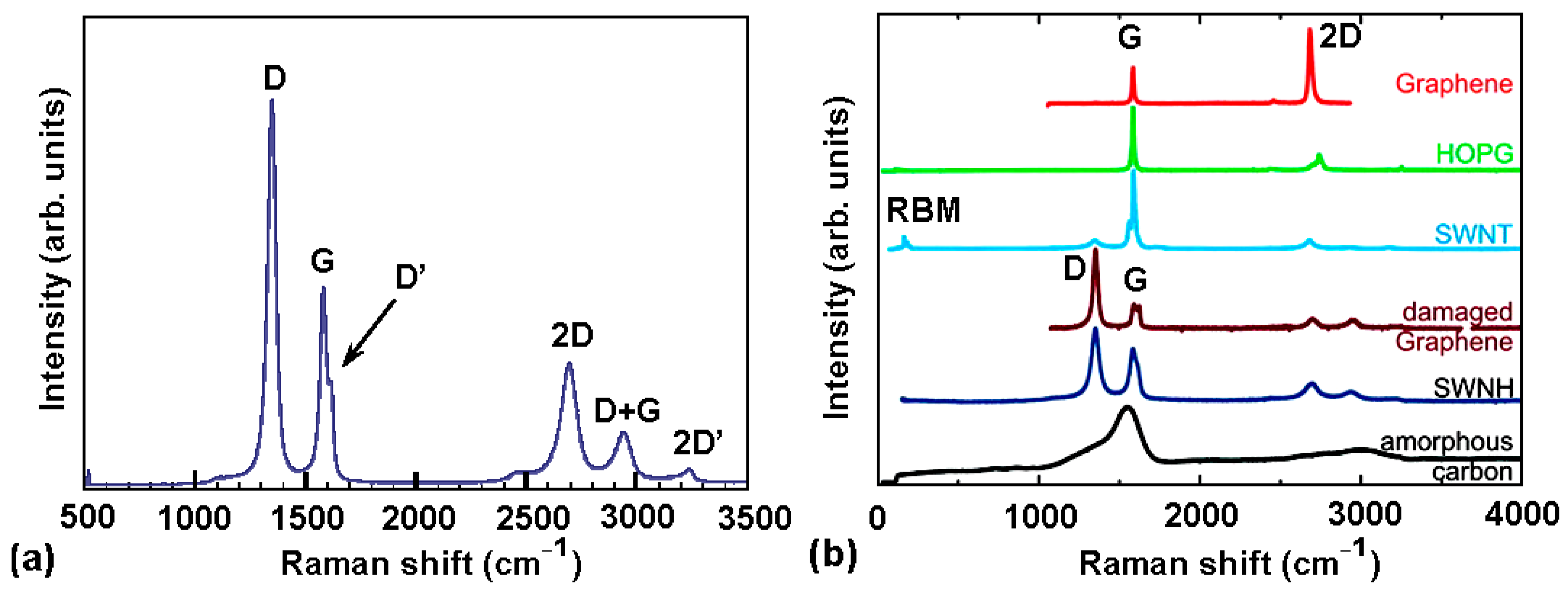
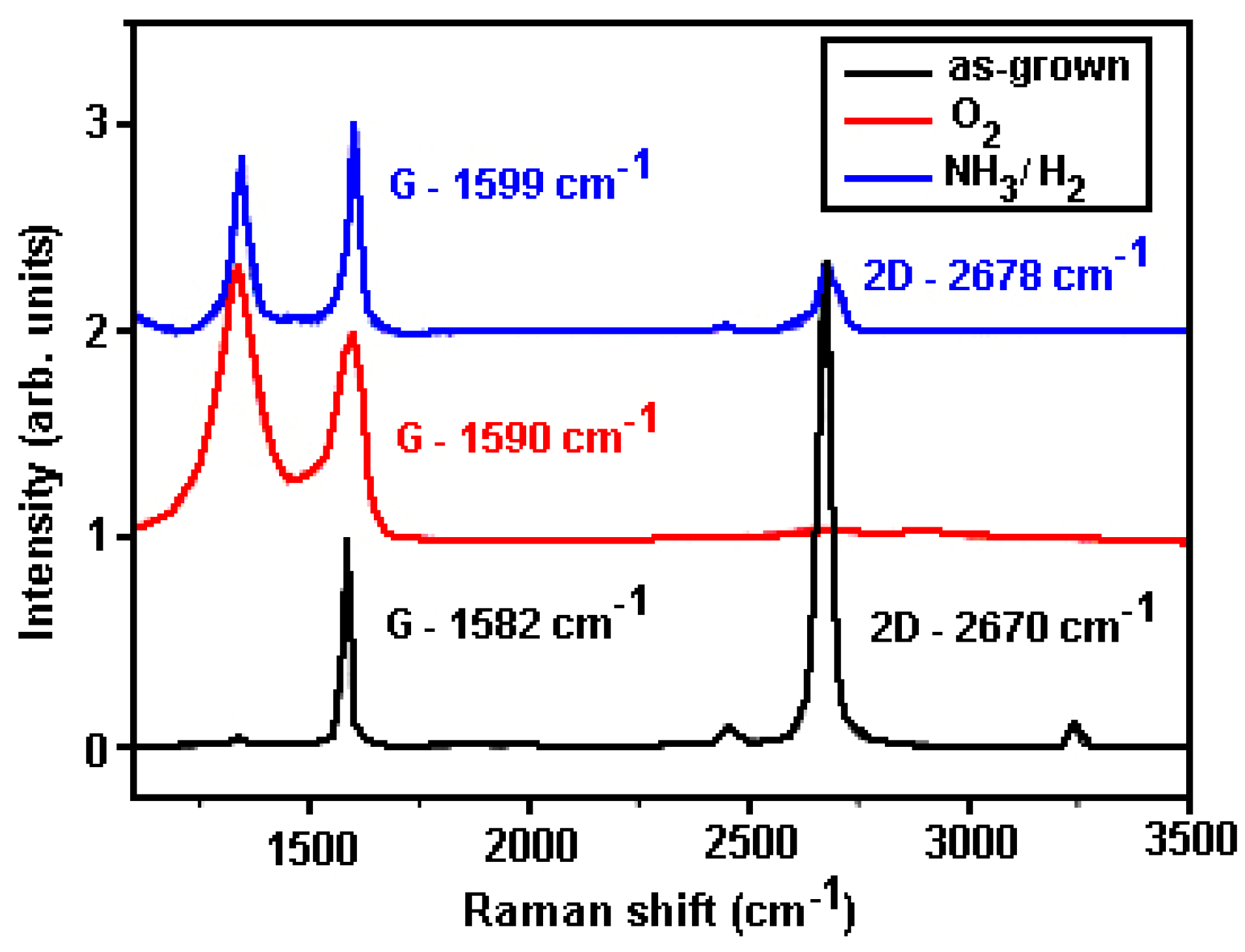
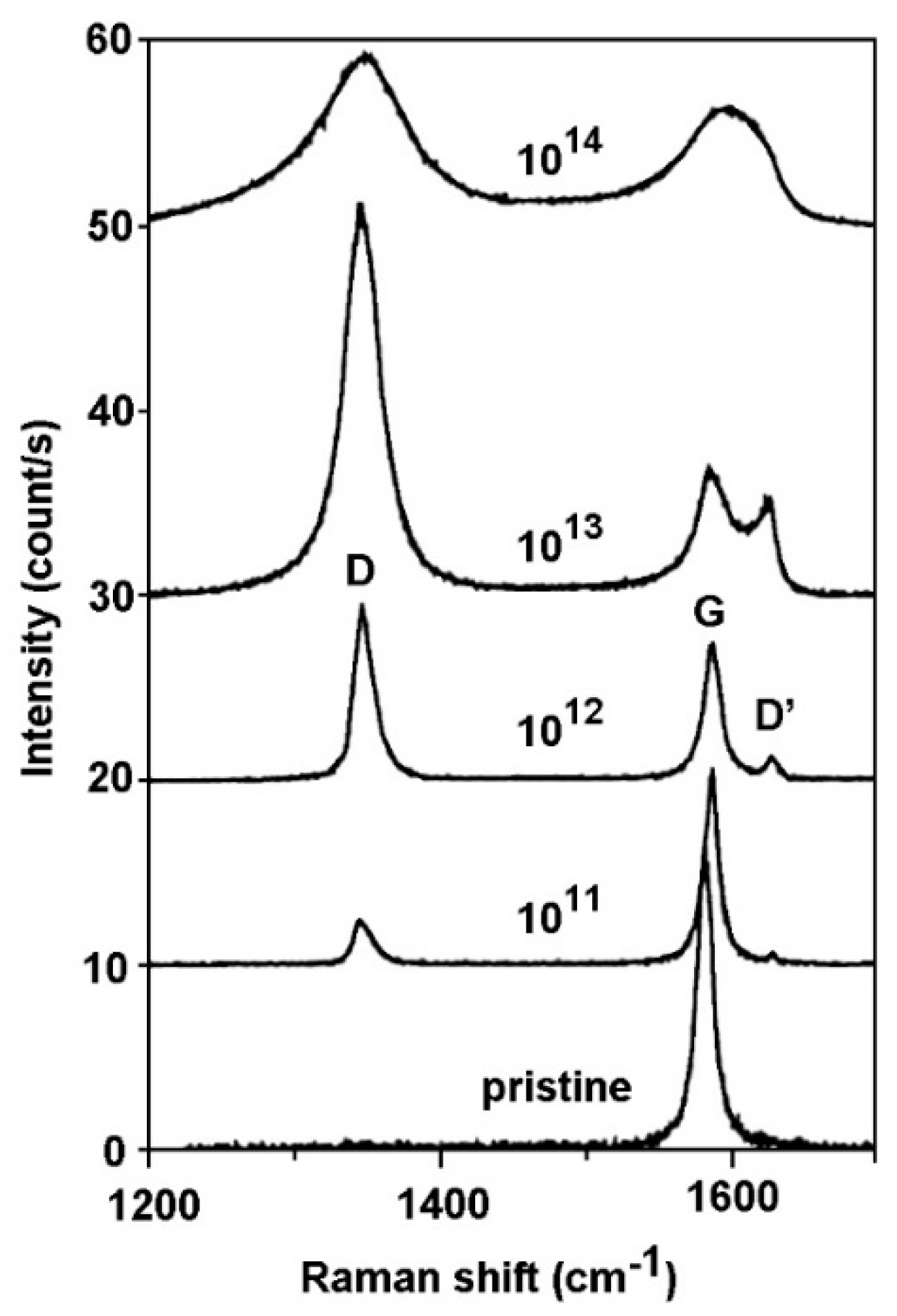
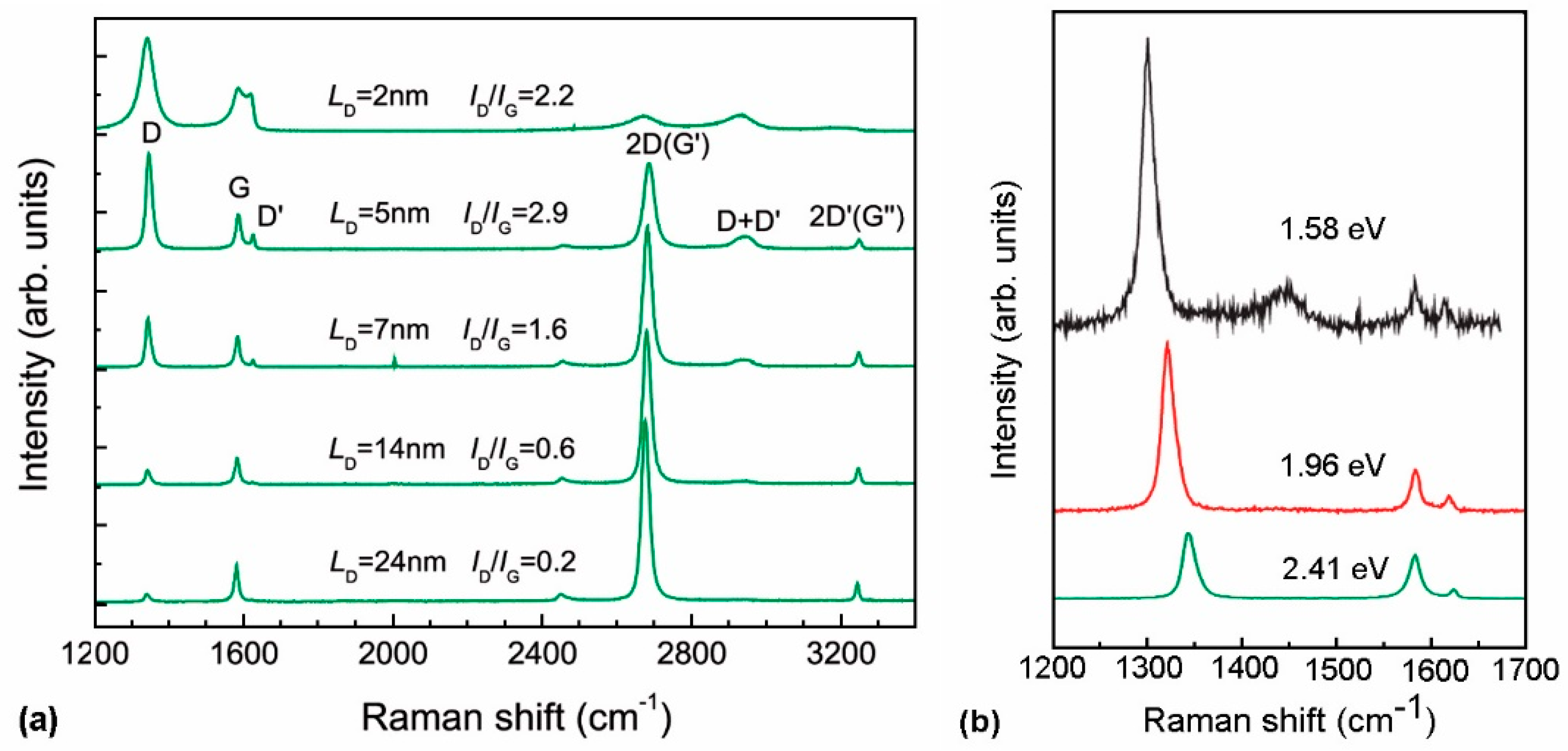
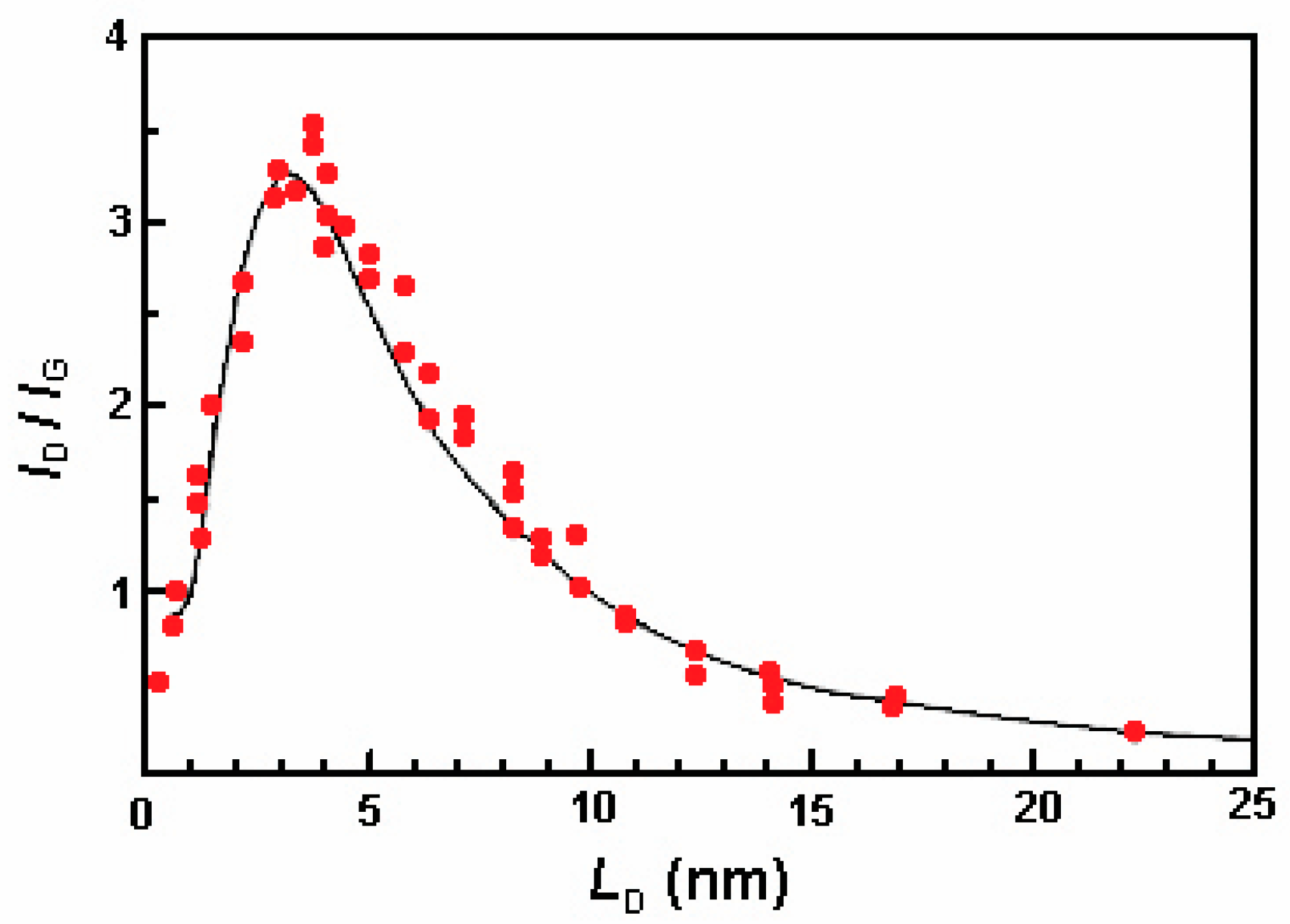
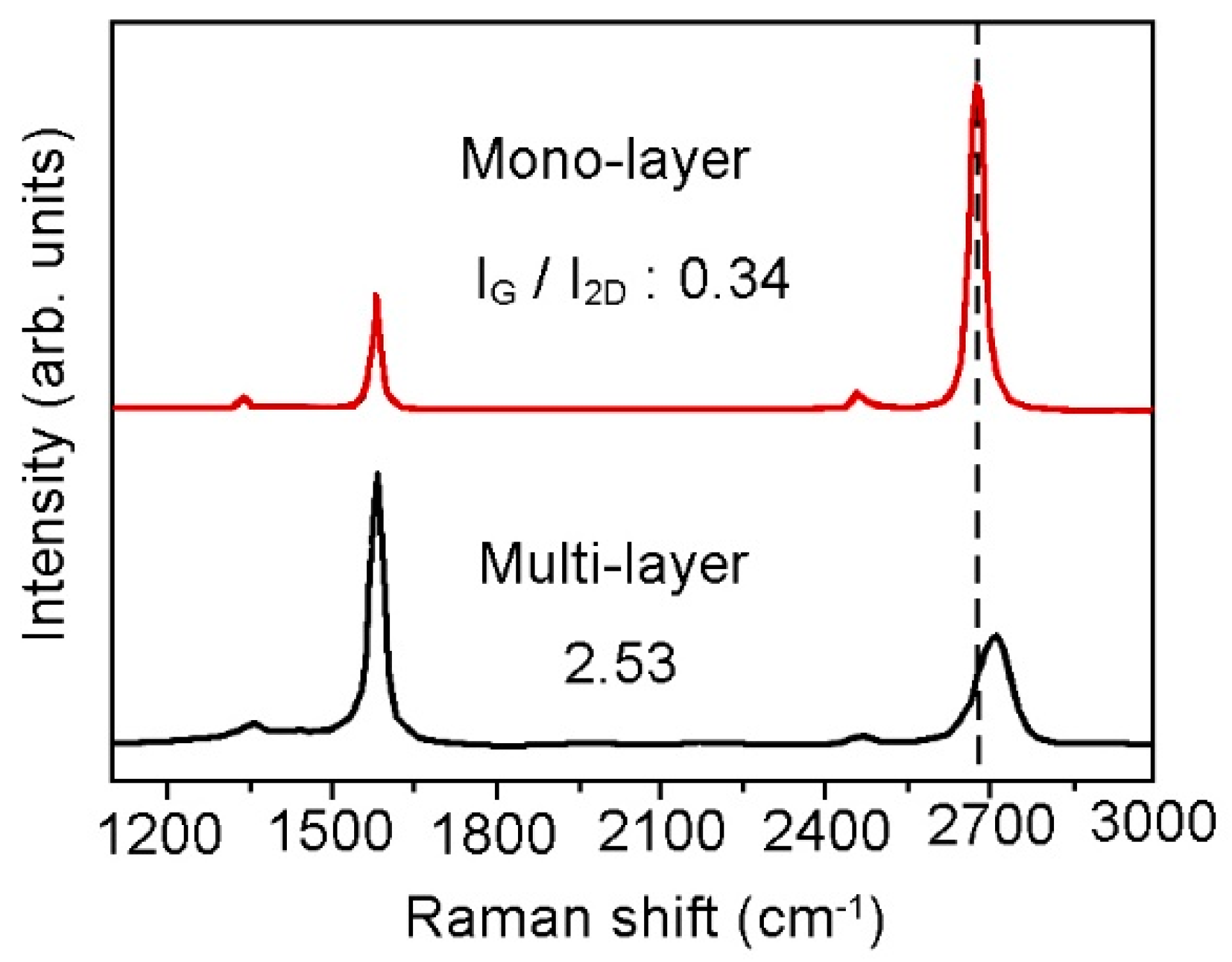
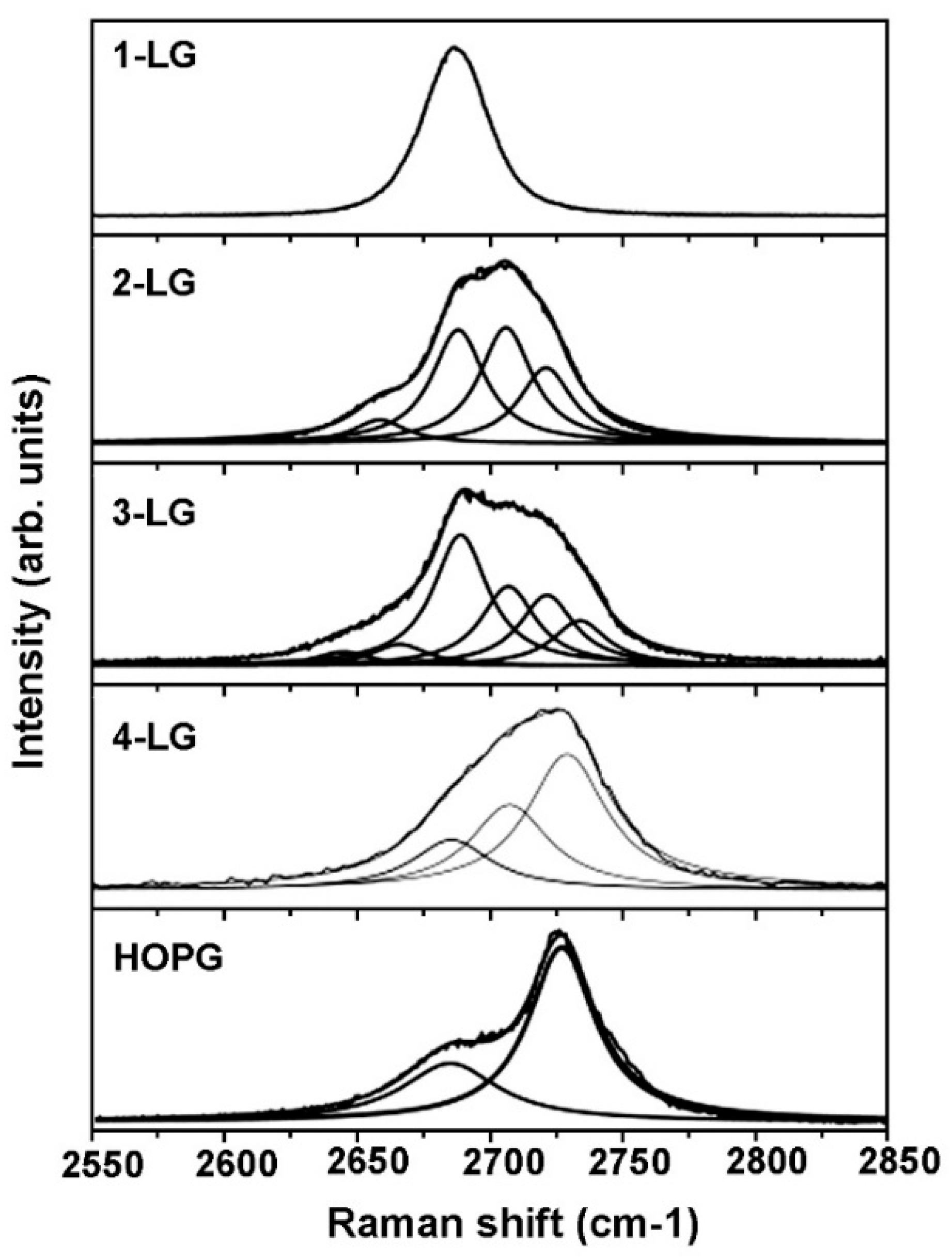
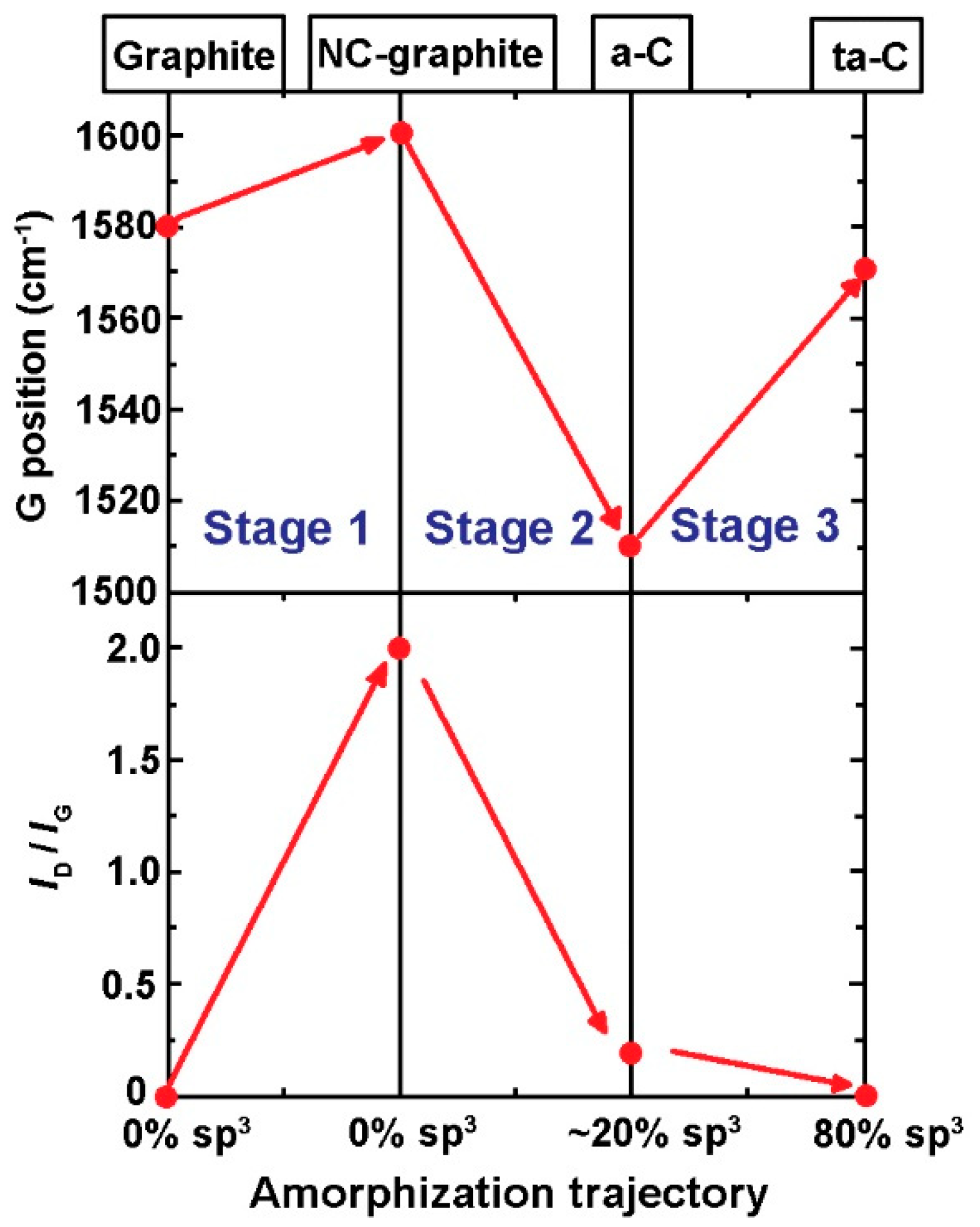
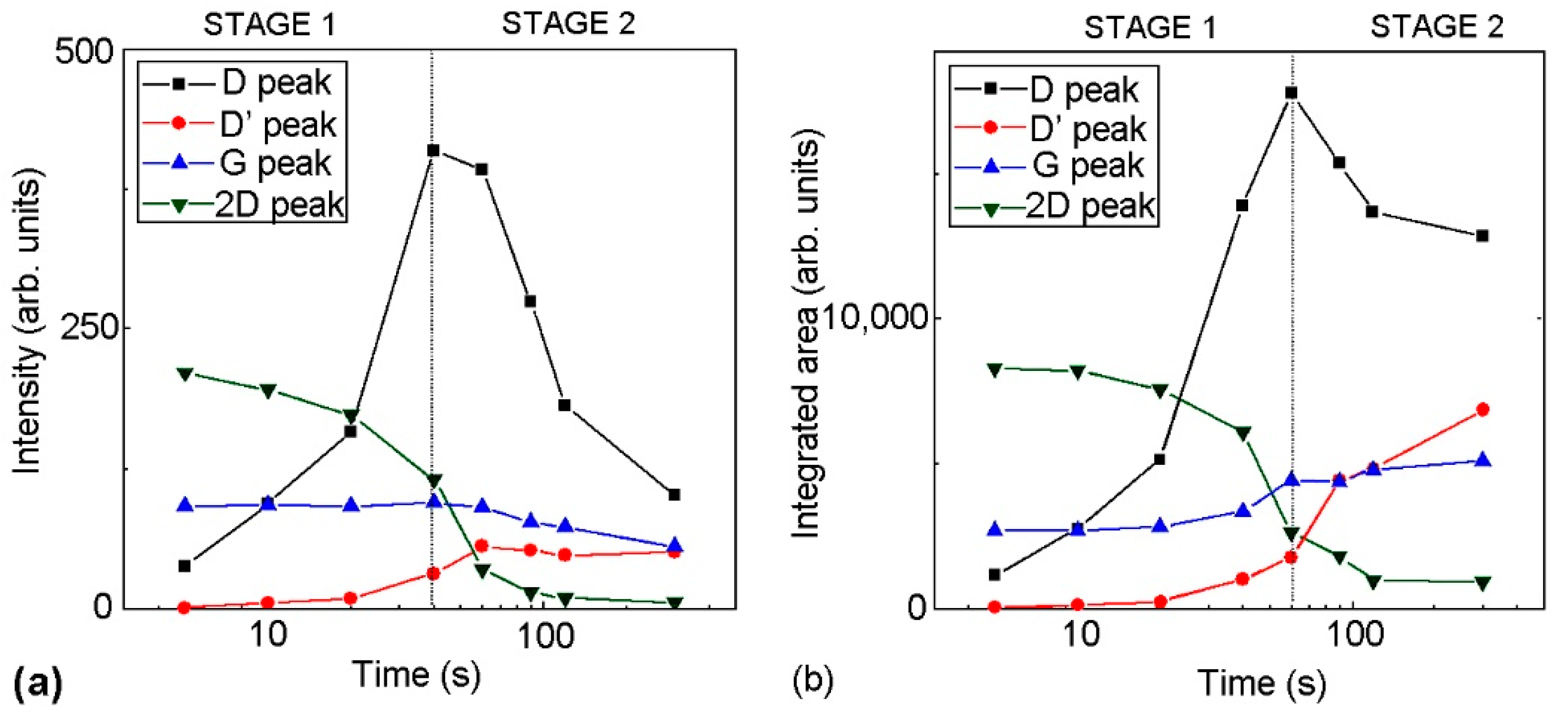
| D Band | D’ Band | 2D Band | G Band | |
|---|---|---|---|---|
| Stage 1 | increase | increase | decrease | ~constant |
| Stage 2 | decrease | increase | sharp decrease | intensity decrease, area increase |
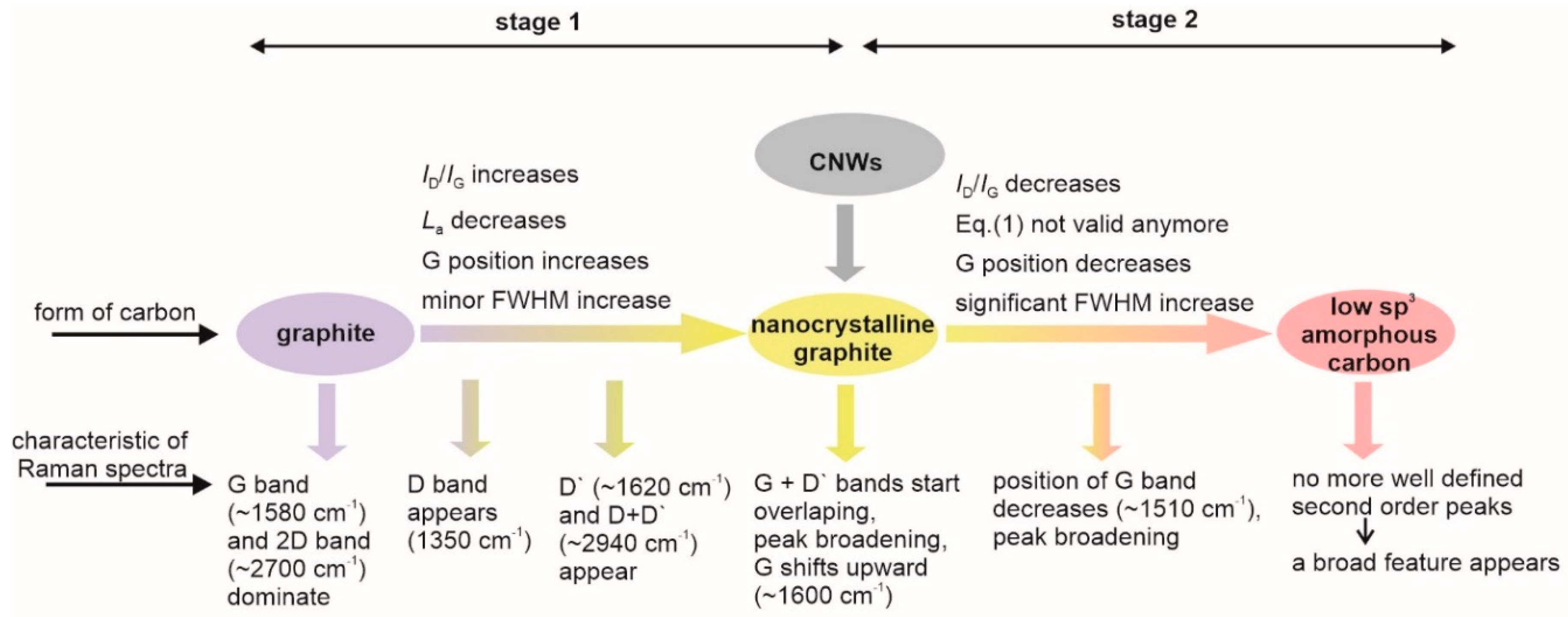
Appendix B. X-ray Photoelectron Spectroscopy of Graphene-Like Materials
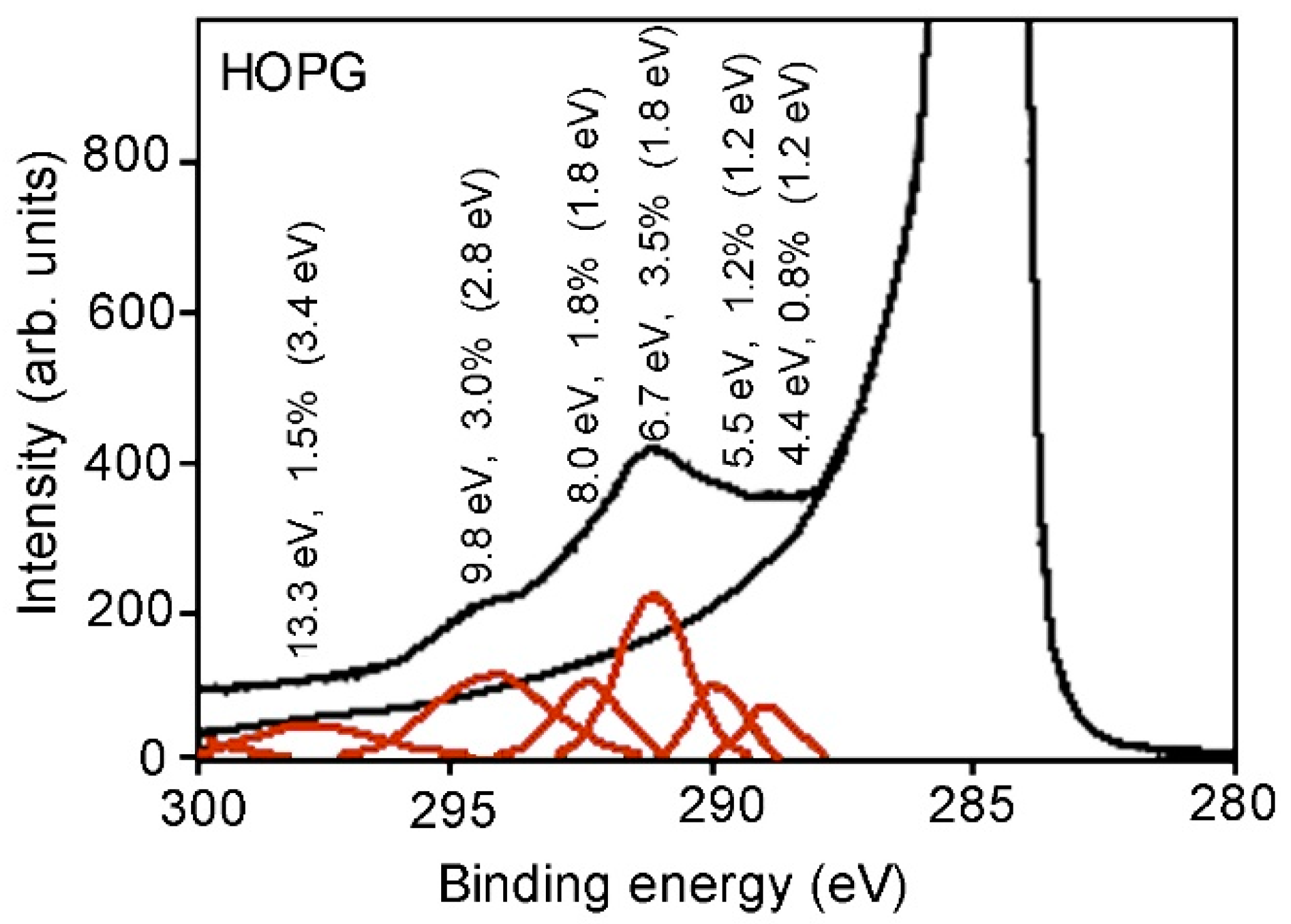
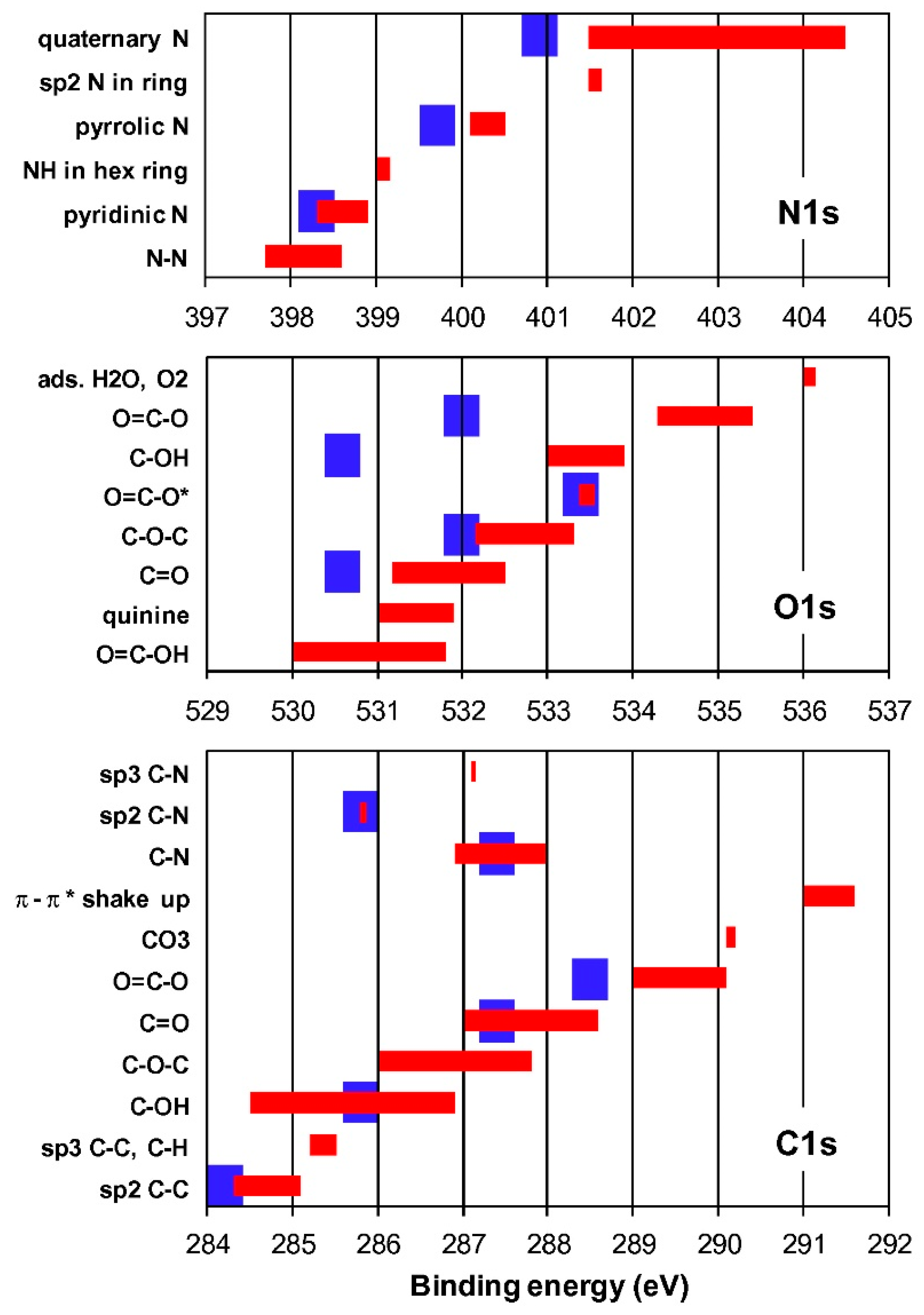
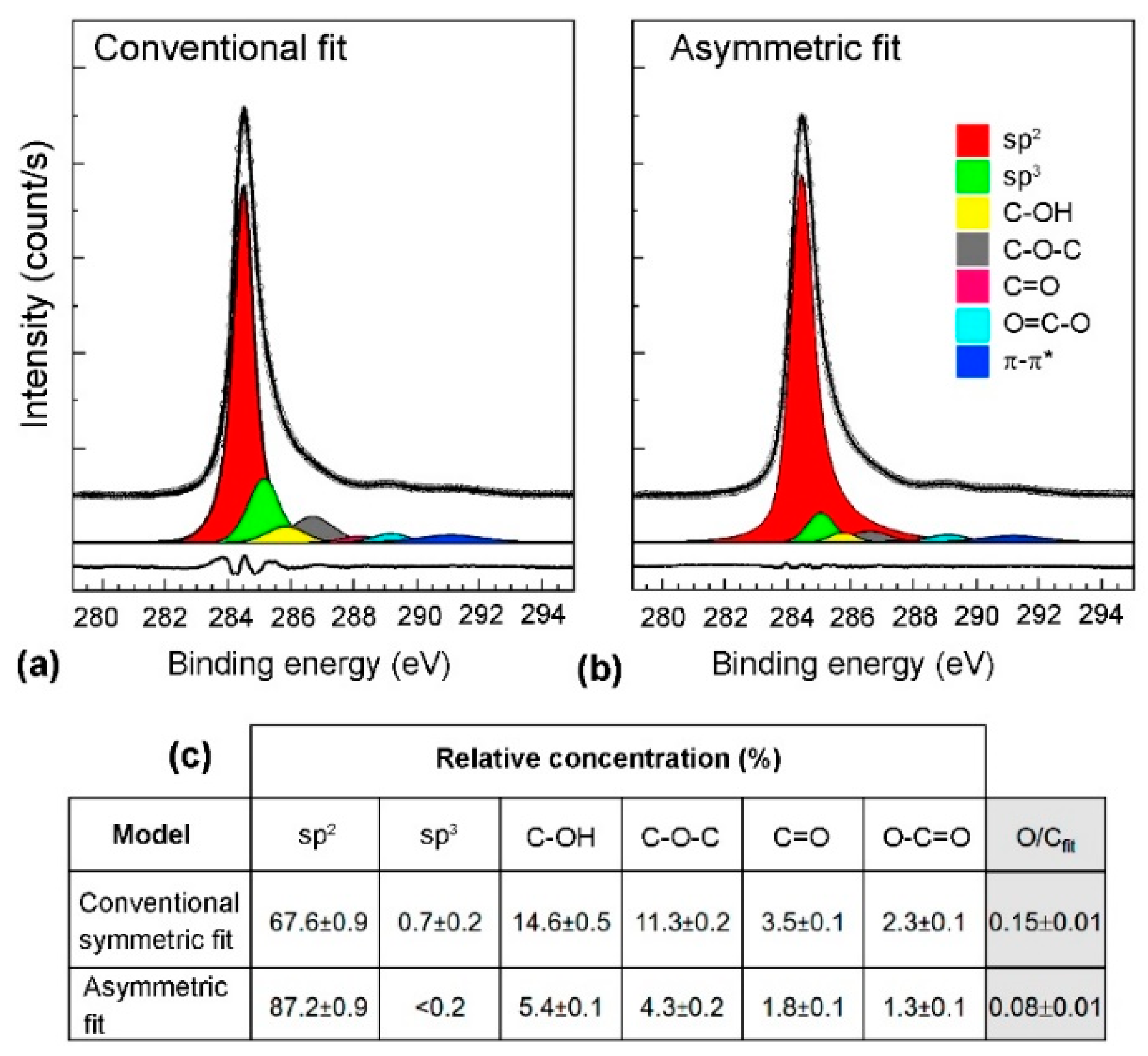
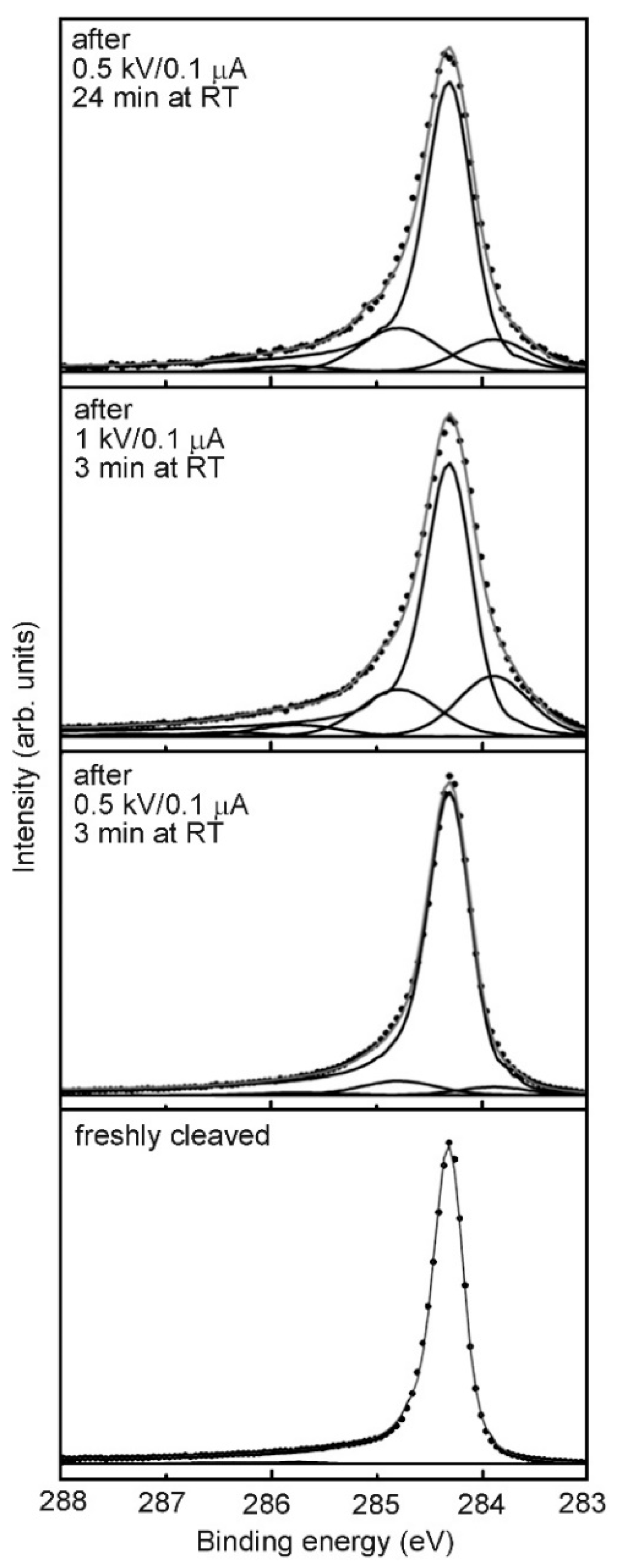
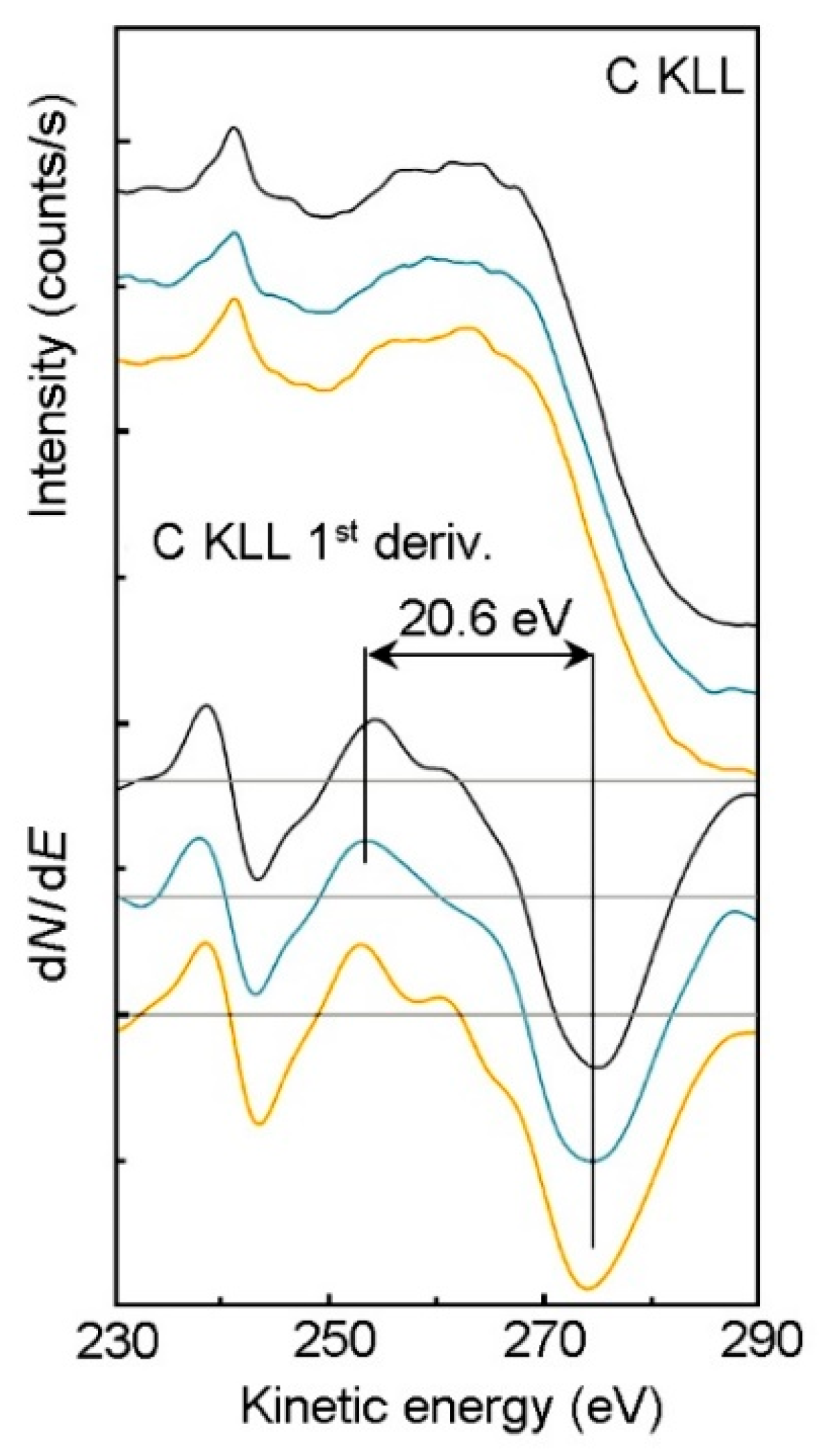
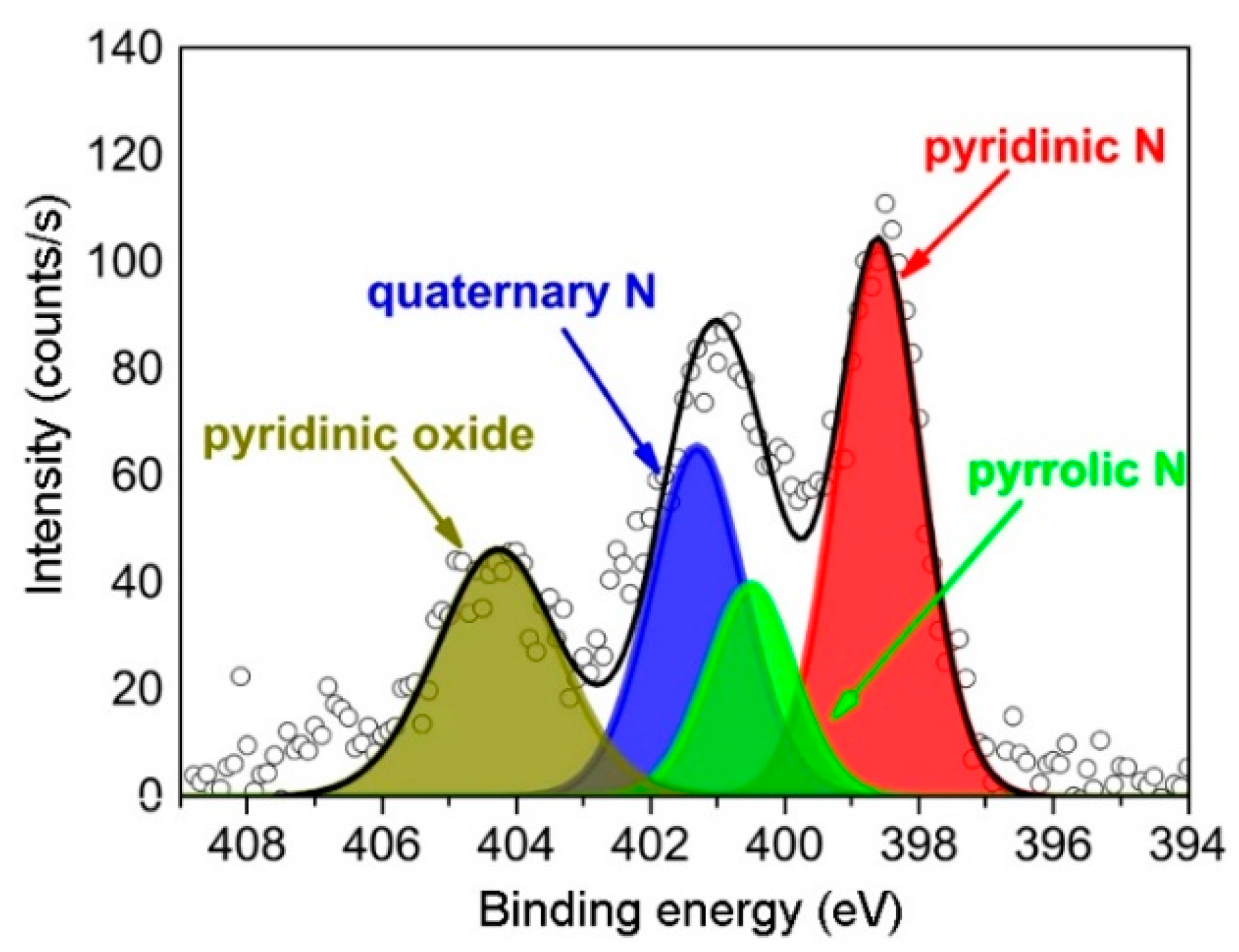
| Pyridinic (N1) | Pyrrolic (N2) | Graphitic/Quaternary (N3) | Amine | Oxidized Forms | Ref. |
|---|---|---|---|---|---|
| 398.3 | 399.7 | 400.9 | [7] | ||
| 398.7 | 400.2 | 402.3 | [14] | ||
| 398.6 | 400.1 | 401.1 | [33] | ||
| 398.9 | 400.2 | 401.7 | [12] | ||
| 398.7 | 400.1 | 401.8 | [31] | ||
| 398.5–398.6 | 399.6–399.8 | 401.1 | [18] | ||
| 398.4 | 399.9 | 401.2 | [72] | ||
| 398.5 | 400.1 | 401.5 | [23] | ||
| 398.2 | 400.1 | 401.7 | 399.0 | [28] | |
| ~398 | ~400 | ~401 | [32] | ||
| 398.7 | 400.3 | 401.4 | ~400.3 | 402–405 | [19] |
| 398.9 | 400.1 | 401.1 | 402.6 | [11] | |
| 398.7 | 400.3 | 401.2 | 402.8 | [43] | |
| 398.5 | 399.9 | 401 | [41] | ||
| 399.4 | / | 401.2 | [15] | ||
| 398.9 | 400.1 | 401.5 | [42] | ||
| 398.3 | 400.5 | / | [4] | ||
| 398.9 | 399.6 | 401.2 | [40] | ||
| 398.4 | / | / | [20] | ||
| / | / | / | 399.6 | [21] | |
| 398.2 | 400.3 | 401.5 | [44] | ||
| / | 399.3 | / | [34] | ||
| 398.3–398.4 | 399.6–399.9 | 400.9–402.4 | 405.6–406.1 | [13] |
References
- Evlashin, S.A.; Fedorov, F.S.; Dyakonov, P.V.; Maksimov, Y.M.; Pilevsky, A.A.; Maslakov, K.I.; Kuzminova, Y.O.; Mankelevich, Y.A.; Voronina, E.N.; Dagesyan, S.A.; et al. Role of nitrogen and oxygen in capacitance formation of carbon nanowalls. J. Phys. Chem. Lett. 2020, 11, 4859–4865. [Google Scholar] [CrossRef] [PubMed]
- Xu, H.; Ma, L.; Jin, Z. Nitrogen-doped graphene: Synthesis, characterizations and energy applications. J. Energy Chem. 2018, 27, 146–160. [Google Scholar] [CrossRef]
- Mahmood, N.; Zhang, C.Z.; Yin, H.; Hou, Y.L. Graphene-based nanocomposites for energy storage and conversion in lithium batteries, supercapacitors and fuel cells. J. Mater. Chem. A 2014, 2, 15–32. [Google Scholar] [CrossRef]
- Qu, L.; Liu, Y.; Baek, J.-B.; Dai, L. Nitrogen-doped graphene as efficient metal-free electrocatalyst for oxygen reduction in fuel cells. ACS Nano 2010, 4, 1321–1326. [Google Scholar] [CrossRef] [PubMed]
- Vesel, A.; Zaplotnik, R.; Primc, G.; Mozetič, M. Synthesis of vertically oriented graphene sheets or carbon nanowalls—Review and challenges. Materials 2019, 12, 2968. [Google Scholar] [CrossRef] [PubMed]
- Schiros, T.; Nordlund, D.; Pálová, L.; Prezzi, D.; Zhao, L.; Kim, K.S.; Wurstbauer, U.; Gutiérrez, C.; Delongchamp, D.; Jaye, C.; et al. Connecting dopant bond type with electronic structure in N-doped graphene. Nano Lett. 2012, 12, 4025–4031. [Google Scholar] [CrossRef]
- Bertóti, I.; Mohai, M.; László, K. Surface modification of graphene and graphite by nitrogen plasma: Determination of chemical state alterations and assignments by quantitative X-ray photoelectron spectroscopy. Carbon 2015, 84, 185–196. [Google Scholar] [CrossRef]
- Boas, C.R.S.V.; Focassio, B.; Marinho, E.; Larrude, D.G.; Salvadori, M.C.; Leão, C.R.; dos Santos, D.J. Characterization of nitrogen doped graphene bilayers synthesized by fast, low temperature microwave plasma-enhanced chemical vapour deposition. Sci. Rep. 2019, 9, 13715. [Google Scholar] [CrossRef]
- Usachov, D.; Vilkov, O.; Grüneis, A.; Haberer, D.; Fedorov, A.; Adamchuk, V.K.; Preobrajenski, A.B.; Dudin, P.; Barinov, A.; Oehzelt, M.; et al. Nitrogen-doped graphene: Efficient growth, structure, and electronic properties. Nano Lett. 2011, 11, 5401–5407. [Google Scholar] [CrossRef]
- Zhao, L.; He, R.; Rim, K.T.; Schiros, T.; Kim, K.S.; Zhou, H.; Gutiérrez, C.; Chockalingam, S.P.; Arguello, C.J.; Pálová, L.; et al. Visualizing individual nitrogen dopants in monolayer graphene. Science 2011, 333, 999–1003. [Google Scholar] [CrossRef]
- Singh, G.; Sutar, D.S.; Botcha, V.D.; Narayanam, P.K.; Talwar, S.S.; Srinivasa, R.S.; Major, S.S. Study of simultaneous reduction and nitrogen doping of graphene oxide Langmuir-Blodgett monolayer sheets by ammonia plasma treatment. Nanotechnol. 2013, 24, 11. [Google Scholar] [CrossRef] [PubMed]
- Cho, H.J.; Kondo, H.; Ishikawa, K.; Sekine, M.; Hiramatsu, M.; Hori, M. Effects of nitrogen plasma post-treatment on electrical conduction of carbon nanowalls. Jpn. J. Appl. Phys. 2014, 53, 4. [Google Scholar] [CrossRef]
- Zhang, J.; Zhao, C.; Liu, N.; Zhang, H.; Liu, J.; Fu, Y.Q.; Guo, B.; Wang, Z.; Lei, S.; Hu, P. Tunable electronic properties of graphene through controlling bonding configurations of doped nitrogen atoms. Sci. Rep. 2016, 6, 28330. [Google Scholar] [CrossRef] [PubMed]
- Bundaleska, N.; Henriques, J.; Abrashev, M.; Botelho do Rego, A.M.; Ferraria, A.M.; Almeida, A.; Dias, F.M.; Valcheva, E.; Arnaudov, B.; Upadhyay, K.K.; et al. Large-scale synthesis of free-standing N-doped graphene using microwave plasma. Sci. Rep. 2018, 8, 12595. [Google Scholar] [CrossRef]
- Tatarova, E.; Dias, A.; Henriques, J.; Abrashev, M.; Bundaleska, N.; Kovacevic, E.; Bundaleski, N.; Cvelbar, U.; Valcheva, E.; Arnaudov, B.; et al. Towards large-scale in free-standing graphene and N-graphene sheets. Sci. Rep. 2017, 7, 10175. [Google Scholar] [CrossRef]
- Terasawa, T.-O.; Saiki, K. Synthesis of nitrogen-doped graphene by plasma-enhanced chemical vapor deposition. Jpn. J. Appl. Phys. 2012, 51, 055101. [Google Scholar] [CrossRef]
- Kumar, A.; Voevodin, A.A.; Paul, R.; Altfeder, I.; Zemlyanov, D.; Zakharov, D.N.; Fisher, T.S. Nitrogen-doped graphene by microwave plasma chemical vapor deposition. Thin Solid Films 2013, 528, 269–273. [Google Scholar] [CrossRef]
- Evlashin, S.A.; Maksimov, Y.M.; Dyakonov, P.V.; Pilevsky, A.A.; Maslakov, K.I.; Mankelevich, Y.A.; Voronina, E.N.; Vavilov, S.V.; Pavlov, A.A.; Zenova, E.V.; et al. N-doped carbon nanowalls for power sources. Sci. Rep. 2019, 9, 6716. [Google Scholar] [CrossRef]
- McClure, J.P.; Thornton, J.D.; Jiang, R.Z.; Chu, D.; Cuomo, J.J.; Fedkiw, P.S. Oxygen reduction on metal-free nitrogen-doped carbon nanowall electrodes. J. Electrochem. Soc. 2012, 159, F733–F742. [Google Scholar] [CrossRef]
- Yen, H.F.; Horng, Y.Y.; Hu, M.S.; Yang, W.H.; Wen, J.R.; Ganguly, A.; Tai, Y.; Chen, K.H.; Chen, L.C. Vertically aligned epitaxial graphene nanowalls with dominated nitrogen doping for superior supercapacitors. Carbon 2015, 82, 124–134. [Google Scholar] [CrossRef]
- Zhao, C.X.; Zhang, Y.; Deng, S.Z.; Xu, N.S.; Chen, J. Surface nitrogen functionality for the enhanced field emission of free-standing few-layer graphene nanowalls. J. Alloys Compd. 2016, 672, 433–439. [Google Scholar] [CrossRef]
- Achour, A.; Solaymani, S.; Vizireanu, S.; Baraket, A.; Vesel, A.; Zine, N.; Errachid, A.; Dinescu, G.; Pireaux, J.J. Effect of nitrogen configuration on carbon nanowall surface: Towards the improvement of electrochemical transduction properties and the stabilization of gold nanoparticles. Mater. Chem. Phys. 2019, 228, 110–117. [Google Scholar] [CrossRef]
- Jeong, H.M.; Lee, J.W.; Shin, W.H.; Choi, Y.J.; Shin, H.J.; Kang, J.K.; Choi, J.W. Nitrogen-doped graphene for high-performance ultracapacitors and the importance of nitrogen-doped sites at basal planes. Nano Lett. 2011, 11, 2472–2477. [Google Scholar] [CrossRef] [PubMed]
- McManus, J.B.; Hennessy, A.; Cullen, C.P.; Hallam, T.; McEvoy, N.; Duesberg, G.S. Controlling defect and dopant concentrations in graphene by remote plasma treatments. Phys. Status Solidi B-Basic Solid State Phys. 2017, 254, 1700214. [Google Scholar] [CrossRef]
- Lin, Y.-P.; Ksari, Y.; Prakash, J.; Giovanelli, L.; Valmalette, J.-C.; Themlin, J.-M. Nitrogen-doping processes of graphene by a versatile plasma-based method. Carbon 2014, 73, 216–224. [Google Scholar] [CrossRef]
- Zeng, J.J.; Lin, Y.J. Tuning the work function of graphene by nitrogen plasma treatment with different radio-frequency powers. Appl. Phys. Lett. 2014, 104, 233103. [Google Scholar] [CrossRef]
- Baraket, M.; Stine, R.; Lee, W.K.; Robinson, J.T.; Tamanaha, C.R.; Sheehan, P.E.; Walton, S.G. Aminated graphene for DNA attachment produced via plasma functionalization. Appl. Phys. Lett. 2012, 100, 233123. [Google Scholar] [CrossRef]
- Lee, B.-J.; Cho, S.-C.; Jeong, G.-H. Atmospheric pressure plasma treatment on graphene grown by chemical vapor deposition. Curr. Appl. Phys. 2015, 15, 563–568. [Google Scholar] [CrossRef]
- Santhosh, N.M.; Filipic, G.; Kovacevic, E.; Jagodar, A.; Berndt, J.; Strunskus, T.; Kondos, H.; Hori, M.; Tatarova, E.; Cvelbar, U. N-graphene nanowalls via plasma nitrogen incorporation and substitution: The experimental evidence. Nanomicro Lett. 2020, 12, 53. [Google Scholar] [CrossRef]
- Manojkumar, P.A.; Krishna, N.G.; Mangamma, G.; Albert, S.K. Understanding the structural and chemical changes in vertical graphene nanowalls upon plasma nitrogen ion implantation. Phys. Chem. Chem. Phys. 2019, 21, 10773–10783. [Google Scholar] [CrossRef]
- Deng, D.; Pan, X.; Yu, L.; Cui, Y.; Jiang, Y.; Qi, J.; Li, W.-X.; Fu, Q.; Ma, X.; Xue, Q.; et al. Toward N-doped graphene via solvothermal synthesis. Chem. Mater. 2011, 23, 1188–1193. [Google Scholar] [CrossRef]
- Lu, Y.-F.; Lo, S.-T.; Lin, J.-C.; Zhang, W.; Lu, J.-Y.; Liu, F.-H.; Tseng, C.-M.; Lee, Y.-H.; Liang, C.-T.; Li, L.-J. Nitrogen-doped graphene sheets grown by chemical vapor deposition: Synthesis and influence of nitrogen impurities on carrier transport. ACS Nano 2013, 7, 6522–6532. [Google Scholar] [CrossRef] [PubMed]
- Amano, T.; Kondo, H.; Takeda, K.; Ishikawa, K.; Hiramatsu, M.; Sekine, M.; Hori, M. Oxygen reduction reaction properties of nitrogen-incorporated nanographenes synthesized using in-liquid plasma from mixture of ethanol and iron phthalocyanine. Jpn. J. Appl. Phys. 2018, 57. [Google Scholar] [CrossRef]
- Luo, Z.; Lim, S.; Tian, Z.; Shang, J.; Lai, L.; MacDonald, B.; Fu, C.; Shen, Z.; Yu, T.; Lin, J. Pyridinic N doped graphene: Synthesis, electronic structure, and electrocatalytic property. J. Mater. Chem. 2011, 21, 8038–8044. [Google Scholar] [CrossRef]
- Sui, Y.; Zhu, B.; Zhang, H.; Shu, H.; Chen, Z.; Zhang, Y.; Zhang, Y.; Wang, B.; Tang, C.; Xie, X.; et al. Temperature-dependent nitrogen configuration of N-doped graphene by chemical vapor deposition. Carbon 2015, 81, 814–820. [Google Scholar] [CrossRef]
- Wei, D.; Liu, Y.; Wang, Y.; Zhang, H.; Huang, L.; Yu, G. Synthesis of N-doped graphene by chemical vapor deposition and its electrical properties. Nano Lett. 2009, 9, 1752–1758. [Google Scholar] [CrossRef] [PubMed]
- Dias, A.; Bundaleski, N.; Tatarova, E.; Dias, F.M.; Abrashev, M.; Cvelbar, U.; Teodoro, O.M.N.D.; Henriques, J. Production of N-graphene by microwave N2-Ar plasma. J. Phys. D Appl. Phys. 2016, 49, 055307. [Google Scholar] [CrossRef]
- Lin, Y.C.; Lin, C.Y.; Chiu, P.W. Controllable graphene N-doping with ammonia plasma. Appl. Phys. Lett. 2010, 96, 133110. [Google Scholar] [CrossRef]
- Kato, T.; Jiao, L.; Wang, X.; Wang, H.; Li, X.; Zhang, L.; Hatakeyama, R.; Dai, H. Room-temperature edge functionalization and doping of graphene by mild plasma. Small 2011, 7, 574–577. [Google Scholar] [CrossRef]
- Yang, W.; Xu, X.; Tu, Z.; Li, Z.; You, B.; Li, Y.; Raj, S.I.; Yang, F.; Zhang, L.; Chen, S.; et al. Nitrogen plasma modified CVD grown graphene as counter electrodes for bifacial dye-sensitized solar cells. Electrochim. Acta 2015, 173, 715–720. [Google Scholar] [CrossRef]
- Sim, U.; Yang, T.-Y.; Moon, J.; An, J.; Hwang, J.; Seo, J.-H.; Lee, J.; Kim, K.Y.; Lee, J.; Han, S.; et al. N-doped monolayer graphene catalyst on silicon photocathode for hydrogen production. Energy Environ. Sci. 2013, 6, 3658–3664. [Google Scholar] [CrossRef]
- Wang, Y.; Shao, Y.; Matson, D.W.; Li, J.; Lin, Y. Nitrogen-doped graphene and its application in electrochemical biosensing. ACS Nano 2010, 4, 1790–1798. [Google Scholar] [CrossRef] [PubMed]
- Shao, Y.; Zhang, S.; Engelhard, M.H.; Li, G.; Shao, G.; Wang, Y.; Liu, J.; Aksay, I.A.; Lin, Y. Nitrogen-doped graphene and its electrochemical applications. J. Mater. Chem. 2010, 20, 7491–7496. [Google Scholar] [CrossRef]
- Zhang, C.; Fu, L.; Liu, N.; Liu, M.; Wang, Y.; Liu, Z. Synthesis of nitrogen-doped graphene using embedded carbon and nitrogen sources. Adv. Mater. 2011, 23, 1020–1024. [Google Scholar] [CrossRef] [PubMed]
- Mozetic, M.; Vesel, A.; Stoica, S.D.; Vizireanu, S.; Dinescu, G.; Zaplotnik, R. Oxygen atom loss coefficient of carbon nanowalls. Appl. Surf. Sci. 2015, 333, 207–213. [Google Scholar] [CrossRef]
- Ferrari, A.C.; Meyer, J.C.; Scardaci, V.; Casiraghi, C.; Lazzeri, M.; Mauri, F.; Piscanec, S.; Jiang, D.; Novoselov, K.S.; Roth, S.; et al. Raman spectrum of graphene and graphene layers. Phys. Rev. Lett. 2006, 97, 187401. [Google Scholar] [CrossRef]
- Hiramatsu, M.; Kondo, H.; Hori, M. Nanoplatform Based on Vertical Nanographene. In Graphene-New Trends and Developments; Ebrahimi, F., Ed.; IntechOpen: Rijeka, Croatia, 2015. [Google Scholar] [CrossRef][Green Version]
- Dresselhaus, M.S.; Jorio, A.; Hofmann, M.; Dresselhaus, G.; Saito, R. Perspectives on carbon nanotubes and graphene Raman spectroscopy. Nano Lett. 2010, 10, 751–758. [Google Scholar] [CrossRef]
- Hiramatsu, M.; Hori, M. Carbon nanowalls: Synthesis and Emerging Applications; Springer: Wien, Austria, 2010. [Google Scholar] [CrossRef]
- Ferrari, A.C.; Robertson, J. Interpretation of Raman spectra of disordered and amorphous carbon. Phys. Rev. B 2000, 61, 14095–14107. [Google Scholar] [CrossRef]
- McEvoy, N.; Nolan, H.; Kumar, N.A.; Hallam, T.; Duesberg, G.S. Functionalisation of graphene surfaces with downstream plasma treatments. Carbon 2013, 54, 283–290. [Google Scholar] [CrossRef]
- Lucchese, M.M.; Stavale, F.; Ferreira, E.H.M.; Vilani, C.; Moutinho, M.V.O.; Capaz, R.B.; Achete, C.A.; Jorio, A. Quantifying ion-induced defects and Raman relaxation length in graphene. Carbon 2010, 48, 1592–1597. [Google Scholar] [CrossRef]
- Cançado, L.G.; Jorio, A.; Ferreira, E.H.M.; Stavale, F.; Achete, C.A.; Capaz, R.B.; Moutinho, M.V.O.; Lombardo, A.; Kulmala, T.S.; Ferrari, A.C. Quantifying defects in graphene via Raman spectroscopy at different excitation energies. Nano Lett. 2011, 11, 3190–3196. [Google Scholar] [CrossRef] [PubMed]
- Tuinstra, F.; Koenig, J.L. Raman spectrum of graphite. J. Chem. Phys. 1970, 53, 1126–1130. [Google Scholar] [CrossRef]
- Knight, D.S.; White, W.B. Characterization of diamond films by Raman spectroscopy. J. Mater. Res. 2011, 4, 385–393. [Google Scholar] [CrossRef]
- Ferrari, A.C. Raman spectroscopy of graphene and graphite: Disorder, electron–phonon coupling, doping and nonadiabatic effects. Solid State Commun. 2007, 143, 47–57. [Google Scholar] [CrossRef]
- Cançado, L.G.; Takai, K.; Enoki, T.; Endo, M.; Kim, Y.A.; Mizusaki, H.; Jorio, A.; Coelho, L.N.; Magalhães-Paniago, R.; Pimenta, M.A. General equation for the determination of the crystallite size La of nanographite by Raman spectroscopy. Appl. Phys. Lett. 2006, 88, 163106. [Google Scholar] [CrossRef]
- Das, A.; Pisana, S.; Chakraborty, B.; Piscanec, S.; Saha, S.K.; Waghmare, U.V.; Novoselov, K.S.; Krishnamurthy, H.R.; Geim, A.K.; Ferrari, A.C.; et al. Monitoring dopants by Raman scattering in an electrochemically top-gated graphene transistor. Nature Nanotechnol. 2008, 3, 210–215. [Google Scholar] [CrossRef]
- Malard, L.M.; Pimenta, M.A.; Dresselhaus, G.; Dresselhaus, M.S. Raman spectroscopy in graphene. Phys. Rep. 2009, 473, 51–87. [Google Scholar] [CrossRef]
- Eckmann, A.; Felten, A.; Mishchenko, A.; Britnell, L.; Krupke, R.; Novoselov, K.S.; Casiraghi, C. Probing the nature of defects in graphene by Raman spectroscopy. Nano Lett. 2012, 12, 3925–3930. [Google Scholar] [CrossRef]
- Leiro, J.A.; Heinonen, M.H.; Laiho, T.; Batirev, I.G. Core-level XPS spectra of fullerene, highly oriented pyrolitic graphite, and glassy carbon. J. Electron Spectros. Relat. Phenom. 2003, 128, 205–213. [Google Scholar] [CrossRef]
- Susi, T.; Pichler, T.; Ayala, P. X-ray photoelectron spectroscopy of graphitic carbon nanomaterials doped with heteroatoms. Beilstein J. Nanotechnol. 2015, 6, 177–192. [Google Scholar] [CrossRef]
- Blume, R.; Rosenthal, D.; Tessonnier, J.-P.; Li, H.; Knop-Gericke, A.; Schlögl, R. Characterizing graphitic carbon with x-ray photoelectron spectroscopy: A step-by-step approach. ChemCatChem 2015, 7, 2871–2881. [Google Scholar] [CrossRef]
- Haq, S.; Tunnicliffe, D.L.; Sails, S.; Savage, J.A. Assessment of nondiamond carbon levels present in chemical vapor deposited diamond by analysis of the plasmon loss features of x-ray photoelectron spectra. Appl. Phys. Lett. 1996, 68, 469–471. [Google Scholar] [CrossRef]
- Fujimoto, A.; Yamada, Y.; Koinuma, M.; Sato, S. Origins of sp3C peaks in C1s X-ray photoelectron spectra of carbon materials. Anal. Chem. 2016, 88, 6110–6114. [Google Scholar] [CrossRef] [PubMed]
- Kovtun, A.; Jones, D.; Dell’Elce, S.; Treossi, E.; Liscio, A.; Palermo, V. Accurate chemical analysis of oxygenated graphene-based materials using X-ray photoelectron spectroscopy. Carbon 2019, 143, 268–275. [Google Scholar] [CrossRef]
- Mezzi, A.; Kaciulis, S. Surface investigation of carbon films: From diamond to graphite. Surf. Interface Anal. 2010, 42, 1082–1084. [Google Scholar] [CrossRef]
- Theodosiou, A.; Spencer, B.F.; Counsell, J.; Jones, A.N. An XPS/UPS study of the surface/near-surface bonding in nuclear grade graphites: A comparison of monatomic and cluster depth-profiling techniques. Appl. Surf. Sci. 2020, 508, 144764. [Google Scholar] [CrossRef]
- Kaciulis, S.; Mezzi, A.; Calvani, P.; Trucchi, D.M. Electron spectroscopy of the main allotropes of carbon. Surf. Interface Anal. 2014, 46, 966–969. [Google Scholar] [CrossRef]
- Yamada, Y.; Kim, J.; Matsuo, S.; Sato, S. Nitrogen-containing graphene analyzed by X-ray photoelectron spectroscopy. Carbon 2014, 70, 59–74. [Google Scholar] [CrossRef]
- Maddi, C.; Bourquard, F.; Barnier, V.; Avila, J.; Asensio, M.-C.; Tite, T.; Donnet, C.; Garrelie, F. Nano-architecture of nitrogen-doped graphene films synthesized from a solid CN source. Sci. Rep. 2018, 8, 3247. [Google Scholar] [CrossRef]
- Huang, L.; Cao, Y.; Diao, D. N-doped graphene sheets induced high electrochemical activity in carbon film. Appl. Surf. Sci. 2019, 470, 205–211. [Google Scholar] [CrossRef]
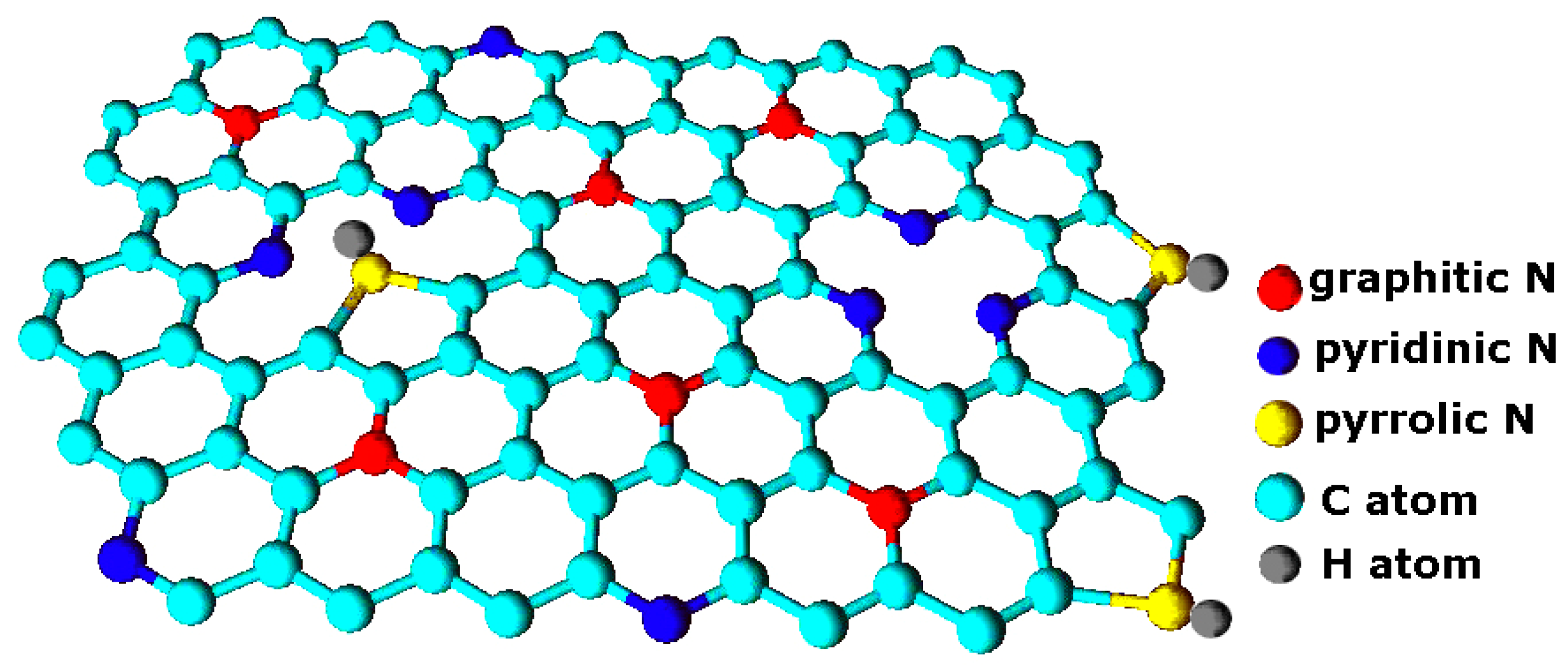
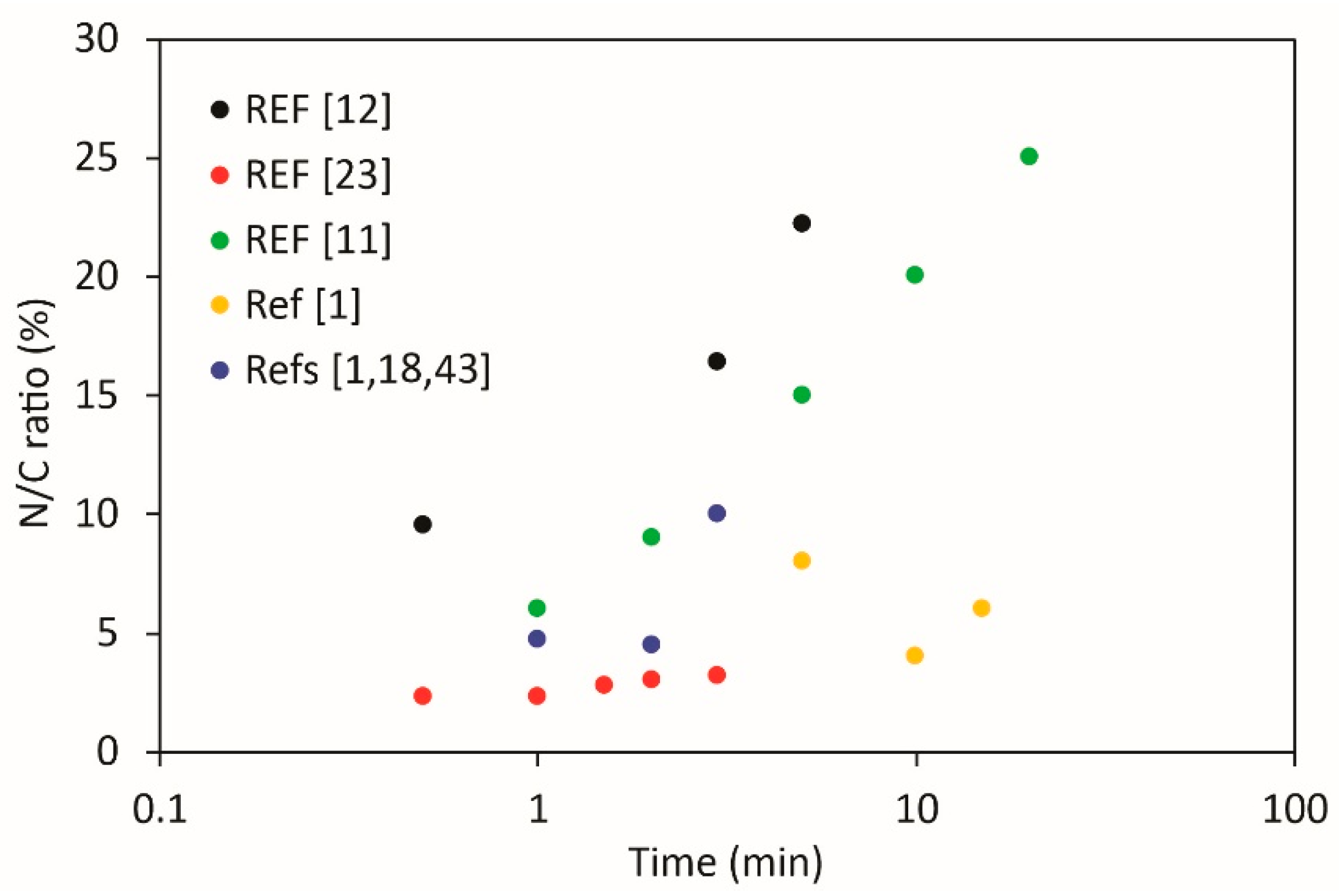
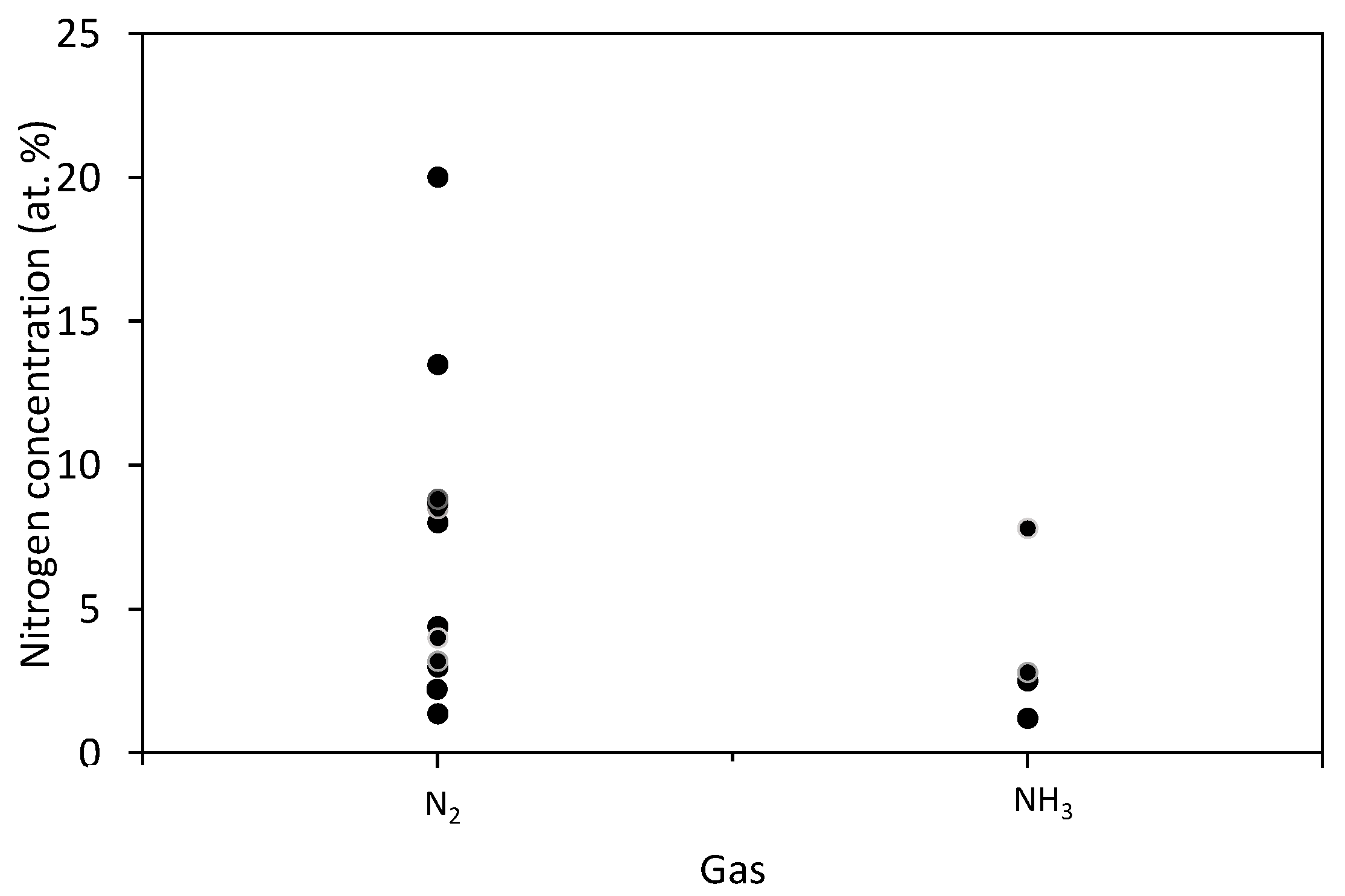
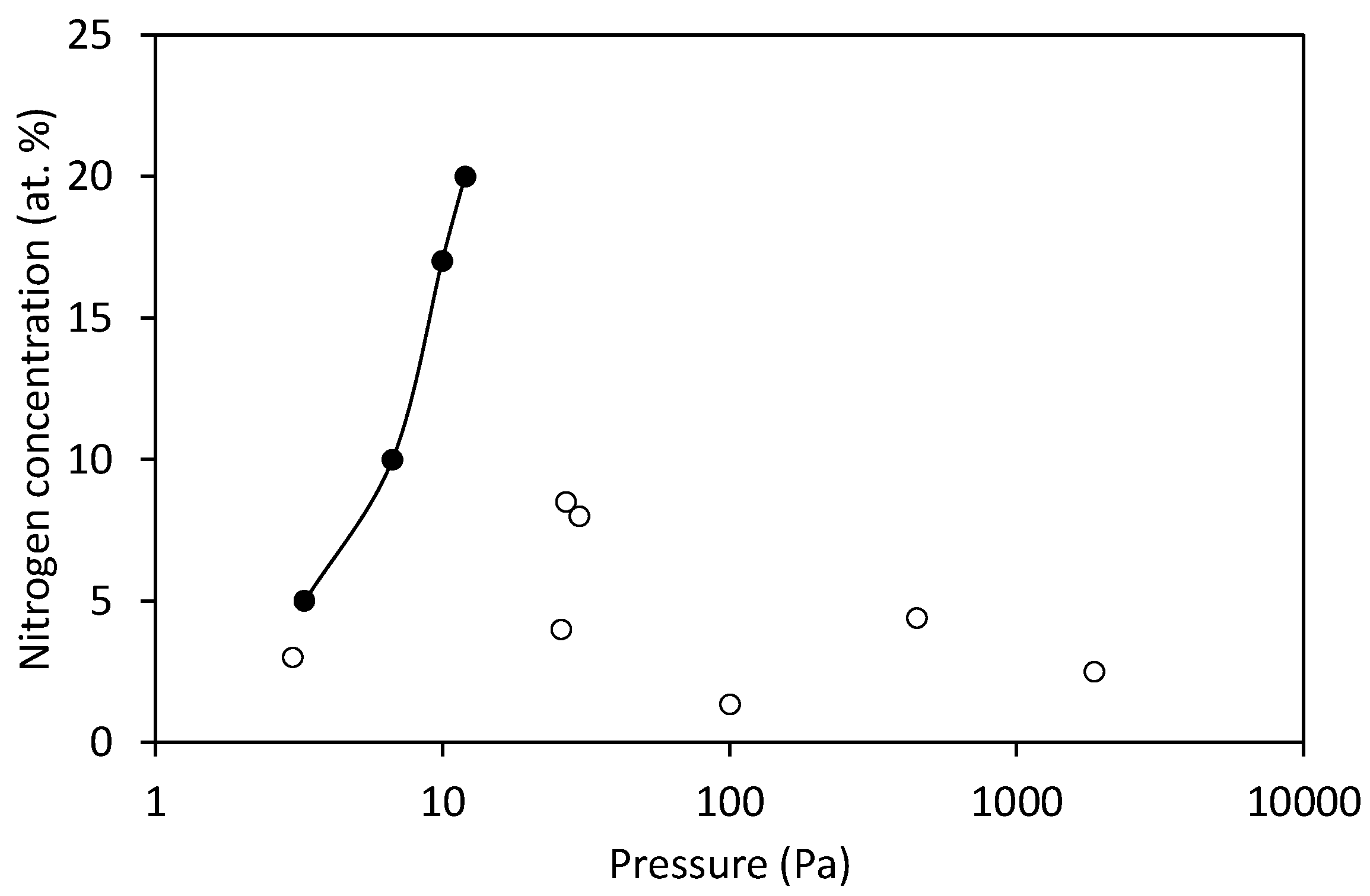
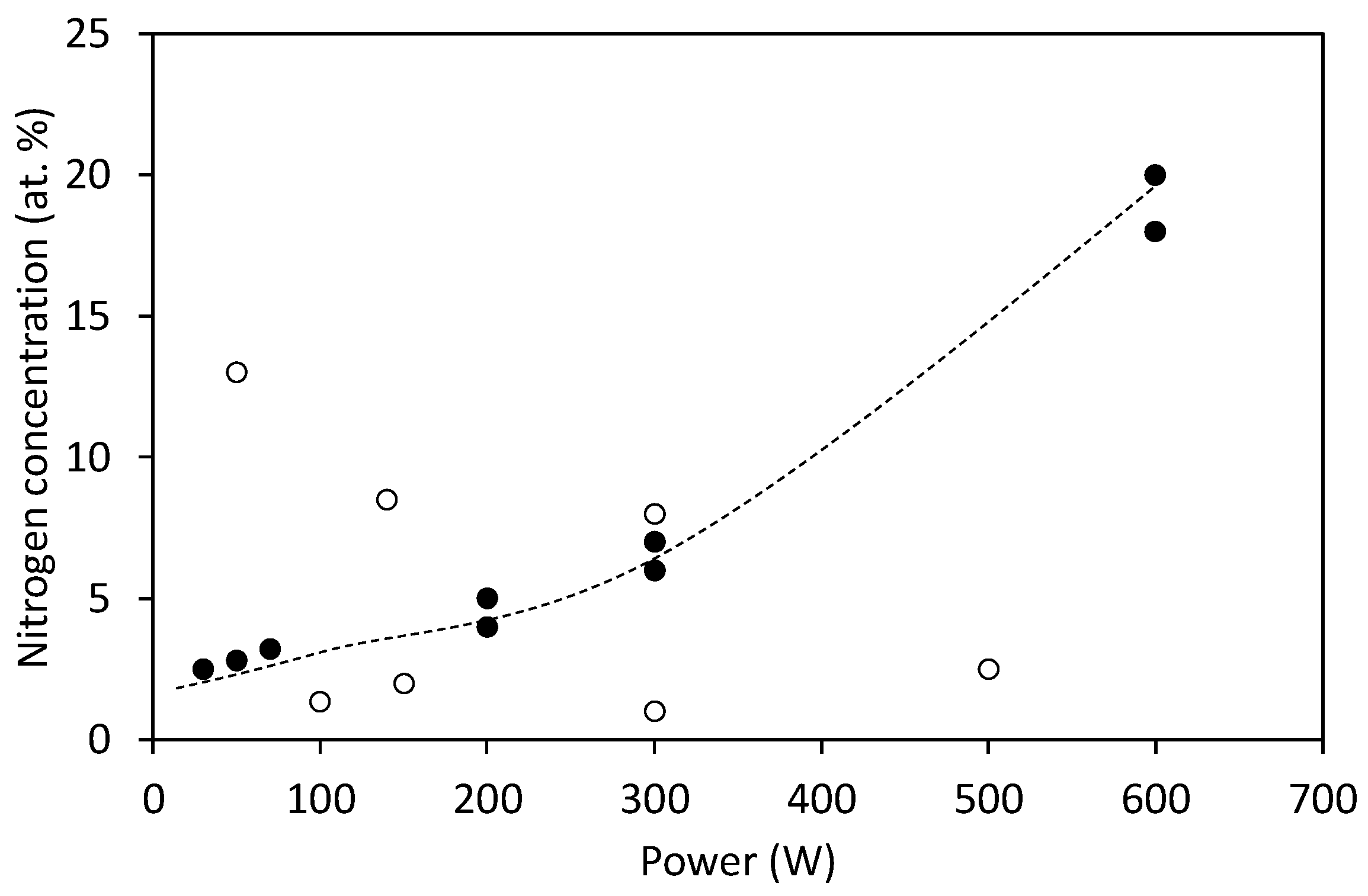
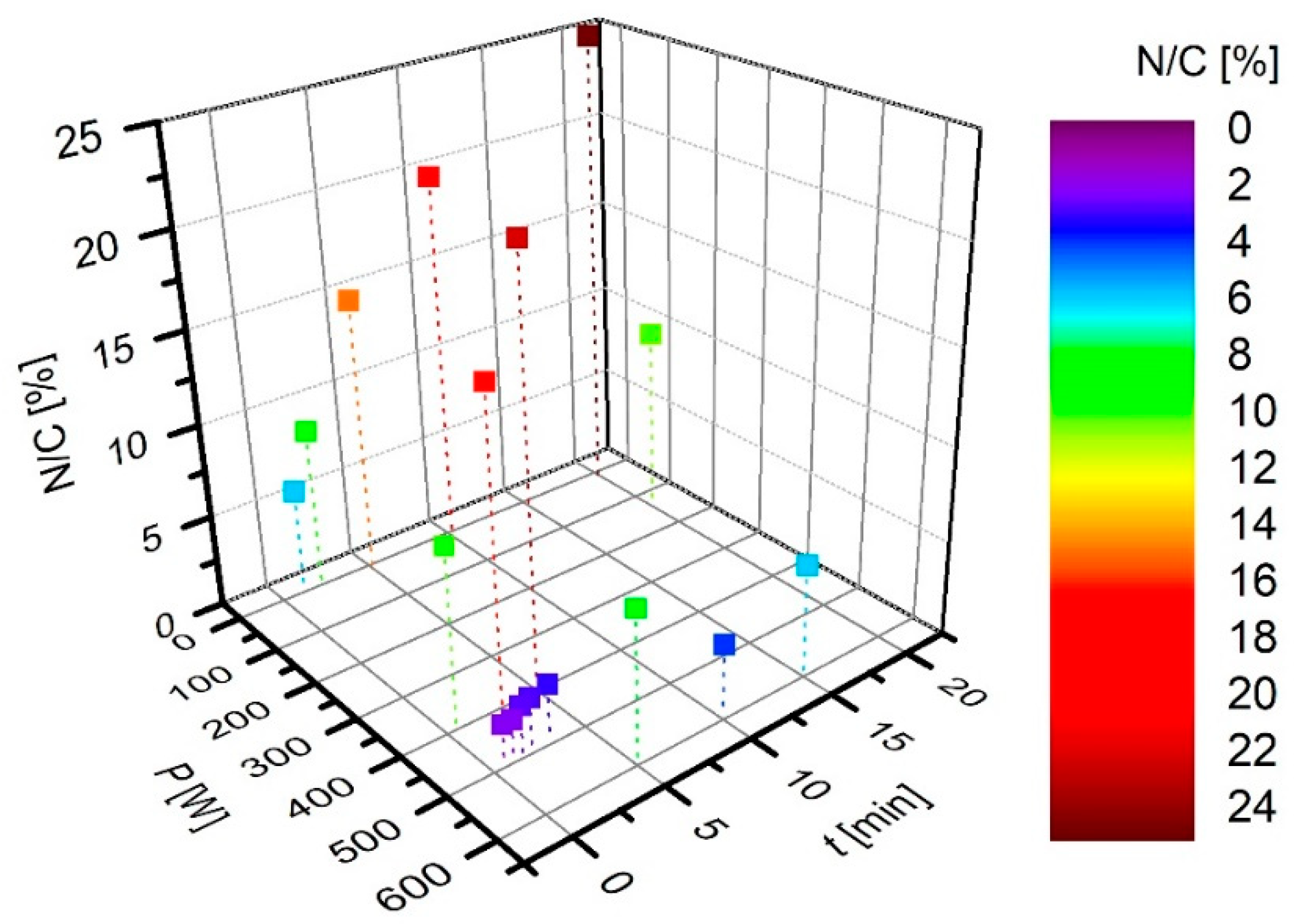
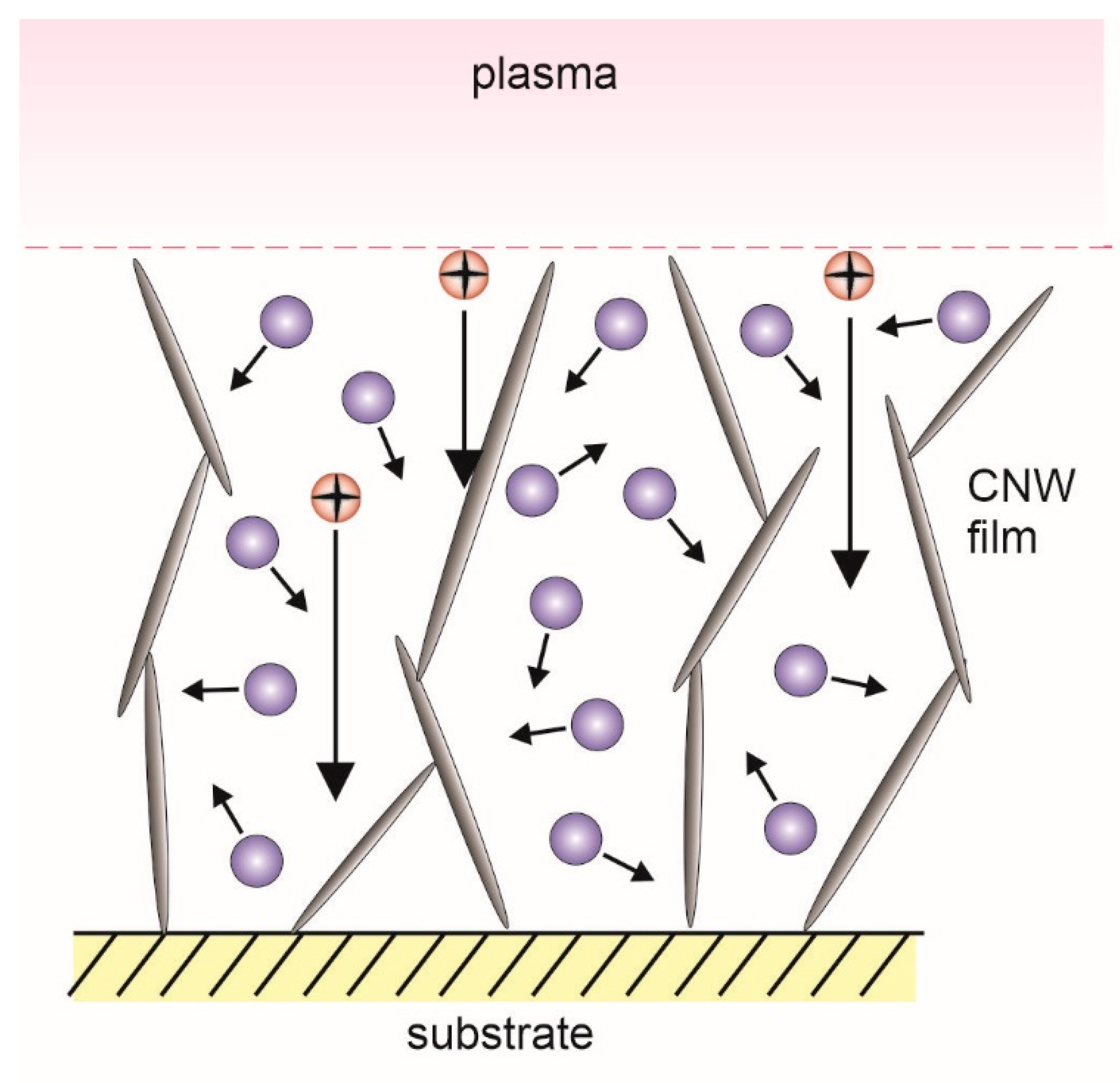
| Ref | Method | Gas | Material | Treatment Parameters for N-Doping | Methods for Characterization | Most Important Conclusions | Possible Application |
|---|---|---|---|---|---|---|---|
| [1] | Post-plasma treatment | N2, O2 or mixture O2:N2 = 25:75 | CNWs | DC discharge, 2kV, 80 mA, pressure: 0.2 Torr, treatment time: 1–120 min (90 min) | SEM, XPS, Raman (/), CV | - 4 at.% N + 10 at.% O, - increased specific capacitance - ID/IG increased from 0.81 to 0.86,1.63, and 1.38 for O2, N2, and O2/N2, respectively; - I2D/IG decreased from 0.95 to 0.72, 0.32, and 0.64 for O2, N2, and O2/N2, respectively, - La decreased from 23.8 nm to 22.4, 11.8, and 14 nm for O2, N2, and O2/N2, respectively | supercapacitors |
| [18] | Post-plasma treatment | N2 | CNWs | DC discharge, pressure: 3 Pa, treatment time: 2 h | SEM, XPS, Raman (/), electrochemical measurements | 3 at.% N + 30 at.% O ID/IG increased from 0.78 to 0.90 after doping | supercapacitors |
| [12] | Post-plasma treatment | N2 | CNWs | CCP plasma, power: 400 W, N2 flow 10 sccm, treatment time: 30–300 s | OES, SEM, XPS, Raman (/), van der Pauw-Hall measurements | Electrical properties depended on treatment time. N/C = 9.5% (30 s)–22.2% (300 s) | electronic application |
| [19] | Post-plasma treatment | N2/Ar(1:2) | CNWs | Pressure: 2 Pa, RF power: 200, 300, 600 W, treatment time: 15 min | XPS, Raman (632.8 nm), TEM, RDE | 4–20 at.% of N 39–52 at.% of O, A change of ID/IG after doping depended on the crystallite size La of non-doped CNWs. | Electrocatalyst for polymer electrolyte membrane fuel cells |
| [20] | Post-plasma treatment | NH3 | Vertical graphene nanowalls | MW PECVD, In-situ doping after CNW synthesis using NH3 | SEM, TEM, XPS, Raman (532 nm), EIS, CV, galvanostatic measurements | 7.8 at.% of N—only pyridinic N was found. Capacitance: 991.6 F/g, Energy density: 275.4 Wh/kg, Power density: 14.8 kW/kg | supercapacitors |
| [30] | Ion implantation | N2 | Vertical graphene nanowalls | RF source of ions, Sample biased with pulsed DC voltage of 2 kV; Treatment time: 10, 20, 30 min | SEM, Raman (514.5 nm), XPS, AFM/AFAM | 7.6–8.8 at.% of N and ~13 at.% of O. Reduction of ID/IG from 2.5 to 1.3. No modification in CNWs morphology up to 20 min. | / |
| [21] | Post-plasma treatment | NH3 | Vertically aligned few-layer graphene (FLG) | PECVD, RF power: 20 W, pressure: 1.4 Torr, NH3 flow rate 50 sccm, substrate temperature: 350 °C, treatment time: 30 min | SEM, TEM, XPS, Raman (514.5 nm), field emission properties | 1.2 at.% of N in the form of amino groups. IG/I2D decreased from 1.53 to 1.03, whereas ID/IG increased from 1.94 to 2.20. Lower work function and enhanced electron emission properties. | Field emitters |
| [22] | Post*-plasma treatment *already pristine CNW contaminated with N | Ar/N2 or Ar/O2 | CNWs | PECVD, RF power 50 W Ar flow 100 sccm, N2 or O2 flow 10 sccm, pressure: 0.2 Pa, treatment time: 5 min | SEM, XPS, Raman (514 nm), CV, EIS | 12.5–13.5 at.% of N. Pyrrolic N was found to be important for improvement of electrochemical transaction. I2D/IG decreased from 0.5 to 0.4 and 0.2, whereas ID/IG decreased from 1.47 to 1.38 and 1.27 for Ar/N2 and Ar/O2, respectively | Electrochemical transductors |
| [23] | Post-plasma treatment | N2 | Graphene layer | PECVD, power: 500 W, pressure: 14 Torr, flow rate 91 sccm, treatment time: up to 3 min followed by annealing at 300 °C for 3 h | TEM, SAED, XRD, SPEM, Raman (/), CV, galvanostatic measurements | 1.7–2.5 at.% of N, 16–25 at.% of O, capacitance 4× larger than for the undoped graphene (280 F/gelectrode), excellent cycle life | ultracapacitors |
| [11] | Post-plasma treatment | NH3 | Graphene oxide monolayer | DC plasma, power: 10 W, pressure: 1 Pa, treatment time 1–20 min | SEM, AFM, XPS, UPS, Raman (514 nm), electrical conductivity | N/C = 6–25%, O/C = 15–27%. Pyridinic, pyrrolic, and graphitic N content depended on treatment time. The best results obtained at low treatment time (n-type). ID/IG increased from 1.5 to 1.9 only for long times. | / |
| [24] | Post-plasma treatment | Ar followed by NH3/H2 | Graphene | MW, remote two-step procedure: Ar plasma (60 s), followed by NH3/H2 (300 s), Ar flow = 200 sccm (2 Torr), NH3 flow = H2 flow = 50 sccm (1 Torr), sample position 30 cm downstream | XPS, Raman (532 nm), electrical measurements | 2.5 at.% of N, n-type I2D/IG = 1.2, ID/IG = 0.02 for pristine graphene. After Ar treatment ID/IG ~ 2.5, after Ar/NH3/H2 treatment ID/IG ~ 1 | transistors |
| [37] | Post-plasma treatment | Ar/N2 | Self-standing graphene sheets | MW power 600 W, Pressure: 100 Pa, total flow 50 sccm, N2:Ar = 10:90, treatment time: 5, 10, and 15 min | Raman (633 nm), XPS, TEM, OES | Pyridinic, pyrrolic and quaternary N, high doping level 5.6%, increase of sp2/sp3 ratio | / |
| [38] | Post-plasma treatment | NH3 | Bilayer graphene | Dose: 3 × 1014 cm−2, other details not specified | XPS, Raman (633 nm) | Doping level: 1.5 × 1013 cm−2. I2D/IG changed from 1.7 to 0.7 | / |
| [39] | Post-plasma treatment | NH3 | Graphene sheet | RF 13.56 MHz, with/without an additional Cu grid in the discharge tube after the coil. Power 20 (45 W) with (without) a grid. Remote treatment at a distance 75 (45) cm and treatment time 60 (10) min with (without) a grid. | AFM, Raman (632.8 nm), electrical measurements | Graphene preferably doped near the edge. Doping density: 1.7 × 1012 cm−2 for mild treatment (with a grid). | / |
| [25] | Post-plasma treatment | N2 | Graphene monolayer | Tunable hybrid ECR-MW plasma source, two modes of operation: (1) an ion-mode with a flux: 4 × 1012 ions s−1 cm−2, energy 35 eV, and (2) an atom-mode (by using an ion trap) with a flux of atoms 2.5 × 1015 s−1 cm−2, sample at 850 °C, pressure 5 × 10−5 mbar, treatment time: 10 min | ARIPES, XPS, LEED | Ion-mode treatment: n-type dopping attributed to 8.7 at.% of graphitic N. Atom-mode treatment:mainly pyridinic N is formed, minor n-doping | / |
| [40] | Post-plasma treatment | N2 | Few-layer graphene | Ion irradiation, DC power supply, negative bias 300–350 V, pressure: 460 Pa, treatment time: 20 and 40 s | XPS, Raman (532 nm), TEM, EIS | 4.4 and 2.8 at.% of N for 40 and 20 s. Mostly pyridinic and pyrrolic N, graphitic only in a minor concentration. 3-times higher energy conversion efficiency. | Solar cells |
| [28] | Post-plasma treatment | N2 | Mono-, few-, and multi-layer graphene | APPJ (15 kV, 25 kHz, AC), flow rate 15 slm, APPJ positioned in N2 surrounding atmosphere, treatment times: 1–30 s, jet distances from the sample: 1, 2, 3 cm | XPS, TEM, WCA, Raman (532 nm) | Pyridinic nitrogen prevailed. ID/IG increased with plasma treatment time from 0.22 to 0.6. Surface change to hydrophilic (contact angle 44°) because of the OH and COOH groups. | / |
| [41] | Post-plasma treatment | N2 | Monolayer graphene | RF plasma 13.56 MHz, power: 10 W, pressure: 0.12 Torr, treatment time: 0–16 s | XPS, Raman (514.5 nm), CV, RDE | Pyridinic N prevailed, followed by pyrrolic and graphitic N. Enhanced electrocatalytic activity and charge transfer. | Hydrogen production |
| [42] | Post-plasma treatment | N2 | Graphene | Harrick model PDC-32G plasma cleaning unit, power: 100 W, pressure: 0.75 Torr, treatment time: 20, 40, 60, 100 min | XPS, TEM, CV, | 1.35 at.% of N and 28 at.% of O. High electrochemical activity for reduction of H2O2. Fast direct electron transfer kinetics for glucose oxidase | Biosensors |
| [43] | Post-plasma treatment | N2 | Graphene sheet | PC2000—Plasma Cleaner, RF 13.56 MHz, power 140 W, pressure: 0.2 Torr, treatment time: 20 min, DC bias 990 V | XPS, Raman (514.5 nm), ORR, CV | 8.5 at.% of N and 8.6 at.% of O. Nitrogen was in all typical configurations with the highest pyrrolic content. Higher electrochemical activity toward oxygen reduction | ORR (fuel cells, biosensors) |
| [26] | Post-plasma treatment | N2 | Graphene films | RF, powers: 30, 50, 70 W, flow rate: 50 sccm, pressure: 0.7 Pa, treatment time: 5 min | XPS, Raman (532 nm), Scanning Kelvin Probe, Van der Pauw-Hall measurements | n-type, mostly graphitic N. ID/IG increased from 0.42 to 0.45, 0.60, 0.81 for 30, 50, and 70 W, respectively. Increased power caused increased graphitic content, increased electron concentration, and a shift of Fermi level to higher energy. Work function decreased. | optoelectronics |
| [27] | Post-plasma treatment | Ar/NH3 | Graphene films | Electron beam plasma, 2 kV, 5% NH3, pressure: 25–90 mTorr, total treatment time: 60 s (equivalent plasma exposure time 6 s) | XPS, Raman (/) | N content increased with increasing pressure from 5 to 20 at.%. Raman D peak also increased with pressure. | biosensors |
| [29] | Post-plasma treatment | N2 or NH3 | Graphene nanowalls | IC RF, power: 300 W, flow rate: 100 sccm, pressure: 30 Pa, post-glow region i.e., 10 cm away from the glow, treatment time: 4, 8, 12, 25 s (for NH3) and 10, 20, 30, 40 s (for N2), pulsed treatment to keep the sample < 50 °C | XPS, SEM, NEXAFS, Raman (633 nm), van der Pauw measurements | 8.0 and 2.8 at.% of N for N2 and NH3, respectively. All three N types were found as well as amine for NH3 treatment. N2 caused etching, which was not observed for NH3. ID/IG was in general decreasing with increasing treatment time: from 2.8 to 2.28 (40 s, N2) or to 2.68 (12 s, NH3). | / |
| Ref | Method | Gas/Precursor | Material | Treatment Parameters for N-Doping | Methods for Characterization | Most Important Conclusions | Possible Application |
|---|---|---|---|---|---|---|---|
| [9] | CVD | s-triazine | Graphene monolayer | vapor pressure: 1 × 10−6 mbar, deposition time: 30 min, temperature: 540–635 °C. | XPS, ARPES, NEXAFS | 1–2 at.% of N (0.4 at.% of graphitic N) Bandgap 0.2 eV | semiconductors |
| [14] | Direct plasma synthesis | Ethanol + NH3 | Free-standing graphene | MW at atmospheric pressure, additional IR and UV treatment for sp2 C and N-type manipulation. Deposition yield: 1.3 mg/min | XPS, SEM, TEM, Raman (633 nm), CV, van der Pauw method, OES and FTIR | N/C = 0.4%,O/C = 1.5%ID/IG ~ 0.9 after irradiation; Higher relative amount of pyridinic and pyrrolic N for the irradiated CNWs. | supercapacitors |
| [44] | Thermal segregation | Few-Layer graphene | Annealing of a substrate consisting of N-containing boron and C-containing Ni films | XPS, Raman (514.5 nm), AFM, electrical characteristic of fabricated field-effect transistors | Higher N doping caused lower La. La reduced from 65 nm to 21 and 8 nm for N/C = 0.6 and 2.9%, respectively Doping level 4 × 1013 cm−2, bandgap 0.16 eV, n-type | nanoelectronics | |
| [31] | Chemical synthesis | CCl4 + Li3N | Few-layer graphene | Reaction of CCl4 with Li3N | STM, TEM, XPS, Raman (633 nm), thermal stability tests | N/C = 4.5–16.4%. In the sample with a high N content, pyridinic and pyrrolic N dominated (p-type). For the sample with a low N content, graphitic N dominated (n-type). | nanoelectronics |
| [32] | CVD | 1,3,5-triazine | Graphene sheets | Chemical vapor deposition of 1,3,5-triazine to Cu substrate at different temperatures 700, 800 and 900 °C | XPS, Raman (473 nm), AFM, SEM, TEM, electrical measurements | N/C = 2.1–5.6%. A lwer temperature was favorable to obtain higher N doping. Increasing of N-doping content caused the transformation of p-type to n-type. | nanoelectronics |
| [4] | CVD | CH4 + NH3 | Few-layer graphene | NH3/CH4/H2/Ar = 10/50/65/200 sccm for 5 min, followed by NH3/Ar for another 5 min, temperature 1000 °C | AFM, TEM, Raman (514.5 nm), XPS, SEM, XRD, RDE | 4 at.% of N, pyridinic, and pyrrolic N-configuration. ID/IG = 0.06–0.25 Improved electrocatalytic activity and stability. | Fuel cells |
| [33] | In-liquid plasma | ethanol + Fe-phthalocy-anine | Nano-graphenes | In-liquid plasma synthesis from ethanol and Fe-phthalocyanine | SEM, XPS, Raman (/), ORR, CV | 6–11 at.% of N, N-configurations: pyridinic, Fe-N, pyrrolic and graphitic. ID/IG = 1.25–1.66, La = 11.6–15. 3 nm | Polymer electrolyte fuel cells |
| [16] | PECVD | H2/CH4/N2 | Mono- to multilayer graphene | Flow rates of H2/CH4/N2 = 20/5/1 sccm. Power 300 W, pressure 1.08 Pa, growth time: 5 min, annealing to 500 and 950 °C. | XPS, Raman (532 nm) | N content: 0.5, and 1.1% at 950 and 500 °C, respectively. N mostly in the graphitic form. I2D/IG = 2.1 (decreasing with N content). ID/IG = 1–1.5. An island like growth. | / |
| [17] | PECVD | H2/CH4/N2 | Few-layer graphene | MW, first H2/CH4 treatment at 500 W, followed by N2/CH4 treatment at 150 W. Pressure: 10 Torr, flow: H2 = CH4 = 10 sccm, N2 = 50 sccm. Total growth time: 5 min. Temperature: 800 °C. | Raman (532 nm), XPS, SEM, TEM | 2 at.% of N in the form of pyridinic, graphitic, and oxygenated form. ID/IG increased from 1.34 to 2.3, and I2D/IG decreased from 1.0 to 0.28. | / |
| [15] | PECVD | Ar/ethanol/N2 +UV | Free- standing graphene | MW, power: 2 kW, Ar flow 1200 sccm, ethanol flow 15 sccm, N2 flow 5 or 10 sccm | XPS, SEM, FTIR, NEXAFS, Raman (532 nm) | 0.2 at.% of N and 8 at.% of O, mostly pyridinic nitrogen and some graphitic, growth yield 2 mg/min. | / |
| [8] | PECVD | H2/CH4/N2 | Graphene bilayers | MW, power: 500 W, N2:CH4 = 2:1, 3:1, or 5:1, H2 flow: 10 sccm, pressure: 43 Torr, deposition time: 2.5 min, temperature: 760 °C | XPS, Raman (532 nm), simulations | 2.0–4.2 at.% of N, pyridinic, and another peak related to other type of N defects. Formation of interlayer bonds mediated by nitrogen defects. ID/IG increased from 0.6 to 2, I2D/IG decreased from 1.5 to 0.7. | / |
| [34] | CVD | H2/C2H4/ NH3 | Single-layer graphene | Thermal deposition in H2/C2H4/NH3 at various NH3 flow rates | XPS, Raman (532 nm), SIMS, UPS, RDE voltametry | N/C = 1.6–16%. Depending on NH3 flow, pure pyridinic N formation. | ORR |
| [35] | CVD | CH4/NH3 | Graphene domain film | Thermal deposition in NH3 and CH4 at various temperatures 880–1050 °C | XPS, Raman (532 nm) | Control of N configuration by growth temperature. At high temperatures, mostly pyridinic N was formed, and pyrrolic N at low temperatures. The N concentration was decreasing with increasing temperature. N = 4.5 and 0.7 at.% at 880 and 1050 °C, respectively. | / |
| [13] | Free-radical reaction | Penta-chloro-pyridine | Graphene films | Free-radical reaction from pentachloropyridine at various growth temperatures 230–600 °C | XPS, Raman, STM, electronic properties | Control of N configuration by growth temperature. Graphitic N dominated at 230–300 °C and pyrrolic N at (400–600 °C). ID/IG = 0.48–1.91 (minimum at 400 °C) La = 7.4–19.6 nm | / |
| Ref | Gas | Discharge | Material | Treatment Time | Power | Pressure/Flow | N and O Content as Obtained by XPS |
|---|---|---|---|---|---|---|---|
| [1] | N2, O2, or mixture | DC | CNWs | 1–120 min (90 min) | 0.2 Torr | N: 4 at.% O: 10 at.% N/C = 4.7% | |
| [18] | N2 | DC | CNWs | 2 h | 3 Pa | N: 3 at.% O: 30 at.% N/C = 4.5% | |
| [12] | N2 | CCP | CNWs | 30, 180, 300 s | 400 W | 10 sccm | N/C = 9.5% at 30 s N/C = 16.4% at 180 s N/C = 22.2% at 300 s |
| [19] | N2/Ar | RF | CNWs | 15 min | 200, 300, and 600 W | 2 Pa | N: 5, 7, or 18 at.%, O: 41, 52 or 39 at.%, N/C = 9, 17 or 42% for 200, 300 and 600 W, respectively (pristine CNW deposited at 860 °C). N: 4, 6, or 20 at.% O: 47, 45, 39 at.% N/C = 8, 12 or 49% for 200, 300 and 600 W, respectively (pristine CNW deposited at 730 °C) |
| [20] | NH3 | MW PECVD | Vertical graphene nanowalls | N: 7.8 at.%, pyridinic N | |||
| [30] | N2 | RF/DC biased | Vertical graphene nanowalls | 10, 20, 30 min | N: 7.6–8.8 at.% O: ~13 at.% N/C ~ 10% | ||
| [21] | NH3 | RF PECVD | Vertically aligned few-layer graphene (FLG) | 30 min | 20 W | 1.4 Torr 50 sccm | N: 1.2 at.%, amino groups |
| [22] | Ar/N2 or Ar/O2 | RF PECVD | CNWs | 5 min | 50 W | 0.2 Pa 100/10 sccm | N: 12.5–13.5 at.% Pyridinic, pyrrolic, graphitic, and oxygenated N |
| [23] | N2 | PECVD | Graphene layer | 0.5–3 min + followed by annealing 3 h | 500 W | 14 Torr 91 sccm | N: 1.7 at.%, O: 25.5 at.%, N/C = 2.3% for 0.5 min N: 1.9 at.%, O: 15.9 at.%, N/C = 2.3% for 1 min N: 2.2 at.%, O: 21.8 at.%, N/C = 2.8% for 1.5 min N: 2.4 at.%, O: 16.9 at.%, N/C = 3.0% for 2 min N: 2.5 at.%, O: 19.6 at.%, N/C = 3.2% for 3 min Pyridinic, pyrrolic and graphitic. Graphitic content was decreasing with increasing treatment time. |
| [11] | NH3 | DC | Graphene oxide monolayer | 1–20 min | 10 W | 1 Pa | N/C = 6%, O/C = 27%, for 1 min N/C = 9%, O/C = 25% for 2 min N/C = 15%, O/C = 15% for 5 min N/C = 20%, O/C = 22% for 10 min N/C = 25%, O/C = 26% for 20 min Pyridinic, pyrrolic and graphitic |
| [24] | Ar + NH3/H2 | MW | Graphene | 60 s in Ar + 300 s in NH3/H2 | 1 Torr, 200/50/50 sccm | N: 2.5 at.% | |
| [37] | Ar/N2 | MW | Self-standing graphene sheets | 5, 10, 15 min | 600 W | 100 Pa 45/5 sccm | N/C ~ 8%, O/C ~ 19% for 5 min N/C ~ 4%, O/C ~ 26% for 10 min N/C ~ 6%, O/C ~ 115% for 15 min (estimated from the graph) Pyridinic, pyrrolic, and graphitic N |
| [25] | N2 | ECR-MW | Graphene monolayer | Two modes of operation: (1) ion-mode, flux = 4 × 1012 ions s−1 cm−2, (2) atom-mode, flux = 2.5 × 1015 s−1 cm−2, | 0.005 Pa | Ion-mode treatment: N: 8.7 at.%, mostly graphitic Atom-mode treatment: Minor doping, mainly pyridinic | |
| [40] | N2 | DC biased | Few–layer graphene | 20 s, 40 s | 460 Pa | N: 4.4 at.% at 40 s N: 2.8 at.% at 20 s Mostly pyridinic and pyrrolic, graphitic N in a minor concentration | |
| [41] | N2 | RF | Monolayer graphene | 14 s | 10 W | 0.12 Torr | 2.2 at.%, pyridinic prevails, followed by pyrrolic and graphitic |
| [42] | N2 | Harrick model PDC-32G plasma cleaning unit | Graphene | 20, 40, 60, 100 min | 100 W | 0.75 Torr | N: 1.35 at.% O: 28 at.% N/C = 1.9% |
| [43] | N2 | RF biased (PC2000—Plasma Cleaner) | Graphene sheets | 20 min | 140 W | 0.2 Torr | N: 8.5 at.% O: 8.6 at.% N/C = 10% Pyridinic, pyrrolic (the highest content), and graphitic |
| [26] | N2 | RF | Graphene films | 5 min | 30, 50, 70 W | 0.7 Pa | N: 2.5, 2.8 and 3.2 at.%, for 30, 50 and 70 W, respectively Mostly graphitic |
| [27] | Ar/NH3 | Electron beam plasma | Graphene films | total treatment time 60 s (equivalent plasma exposure time 6 s) | 25–90 mTorr | N: 5 at.% at 3.3 Pa N: 10 at.% at 6.7 Pa N: 17 at.% at 10 Pa N: 20 at.% at 12 Pa | |
| [29] | N2 or NH3 | RF | Graphene nanowalls | 4, 8, 12, 25 s (for NH3) 10, 20, 30, 40 s (for N2) | 300 W | 30 Pa | N: 8.0 and 2.8 at.% for N2 and NH3, respectively Pyridinic, pyrrolic and graphitic N, as well as amine in the case of NH3 treatment |
| [14] | EtOH/ NH3 | MW | Free-standing graphene | / | Atmospheric | N/C = 0.4%, O/C = 1.5% Higher amounts of pyridinic and pyrrolic N, if irradiated. | |
| [33] | EtOH and Fe-phthalo-cyanine | In-liquid plasma | Nano-graphenes | N: 6–11 at.% Pyridinic, Fe-N, pyrrolic, and graphitic N | |||
| [16] | H2/CH4/N2 | PECVD | Mono- to multilayer graphene | 5 min | 300 W | 1.08 Pa | N: 0.5%–1.1% for 950 and 500 °C, respectively Mostly graphitic N. |
| [17] | H2/CH4/N2 | PECVD | Few-layer graphene | 5 min | 500 W | 10 Torr 10/10/50 sccm | N: 2 at.% Pyridinic, graphitic and oxygenated N |
| [8] | N2/H2/CH4 | MW PECVD | Graphene bilayers | 2.5 min | 500 W | 43 Torr | N: 2.0 at.% for N2:CH4 = 2:1 N: 4.2 at.% for N2:CH4 = 3:1 and 5:1 Pyridinic N and another one related to other type of defects |
| [15] | Ar/EtOH/N2 | MW PECVD + UV | Free- standing graphene | / | 2000 W | 1200/15/(5 or 10) sccm | N: 0.2 at.% O: 8 at.% Mostly pyridinic and some graphitic |
Publisher’s Note: MDPI stays neutral with regard to jurisdictional claims in published maps and institutional affiliations. |
© 2020 by the authors. Licensee MDPI, Basel, Switzerland. This article is an open access article distributed under the terms and conditions of the Creative Commons Attribution (CC BY) license (http://creativecommons.org/licenses/by/4.0/).
Share and Cite
Vesel, A.; Zaplotnik, R.; Primc, G.; Mozetič, M. A Review of Strategies for the Synthesis of N-Doped Graphene-Like Materials. Nanomaterials 2020, 10, 2286. https://doi.org/10.3390/nano10112286
Vesel A, Zaplotnik R, Primc G, Mozetič M. A Review of Strategies for the Synthesis of N-Doped Graphene-Like Materials. Nanomaterials. 2020; 10(11):2286. https://doi.org/10.3390/nano10112286
Chicago/Turabian StyleVesel, Alenka, Rok Zaplotnik, Gregor Primc, and Miran Mozetič. 2020. "A Review of Strategies for the Synthesis of N-Doped Graphene-Like Materials" Nanomaterials 10, no. 11: 2286. https://doi.org/10.3390/nano10112286
APA StyleVesel, A., Zaplotnik, R., Primc, G., & Mozetič, M. (2020). A Review of Strategies for the Synthesis of N-Doped Graphene-Like Materials. Nanomaterials, 10(11), 2286. https://doi.org/10.3390/nano10112286








